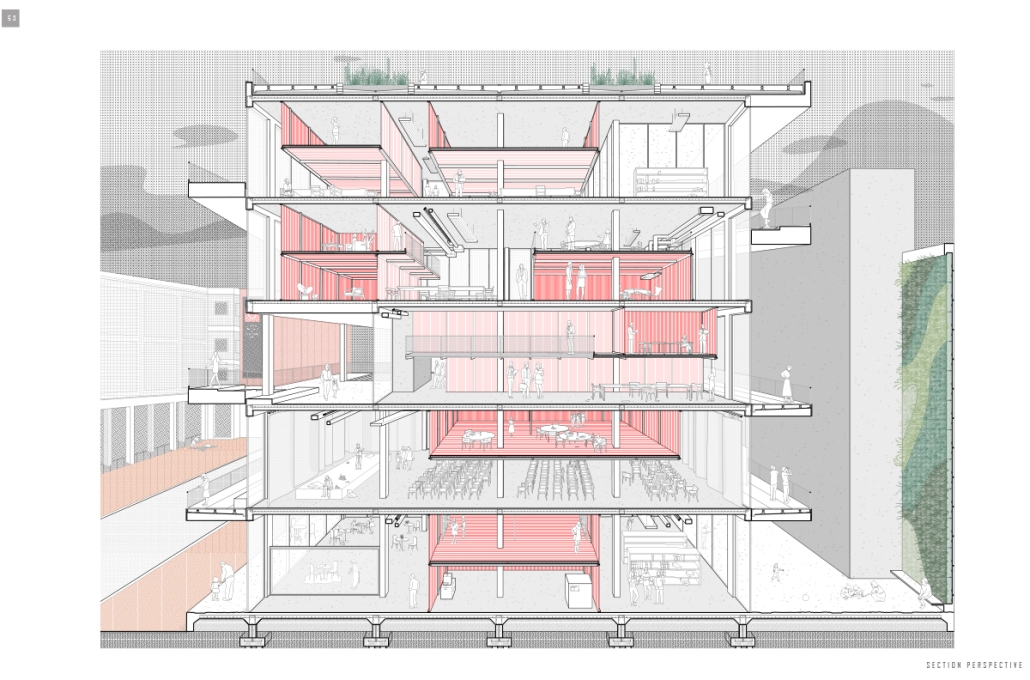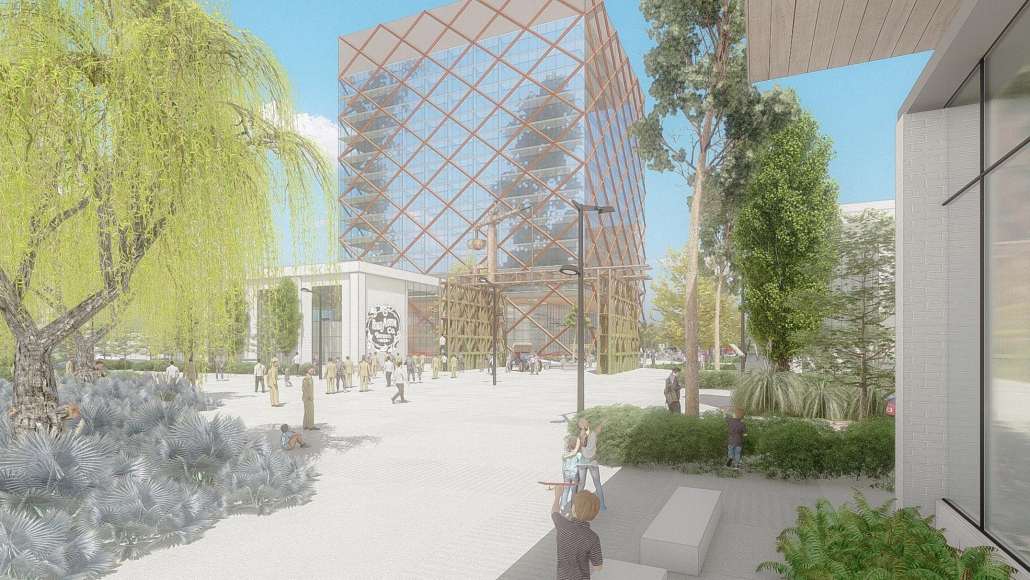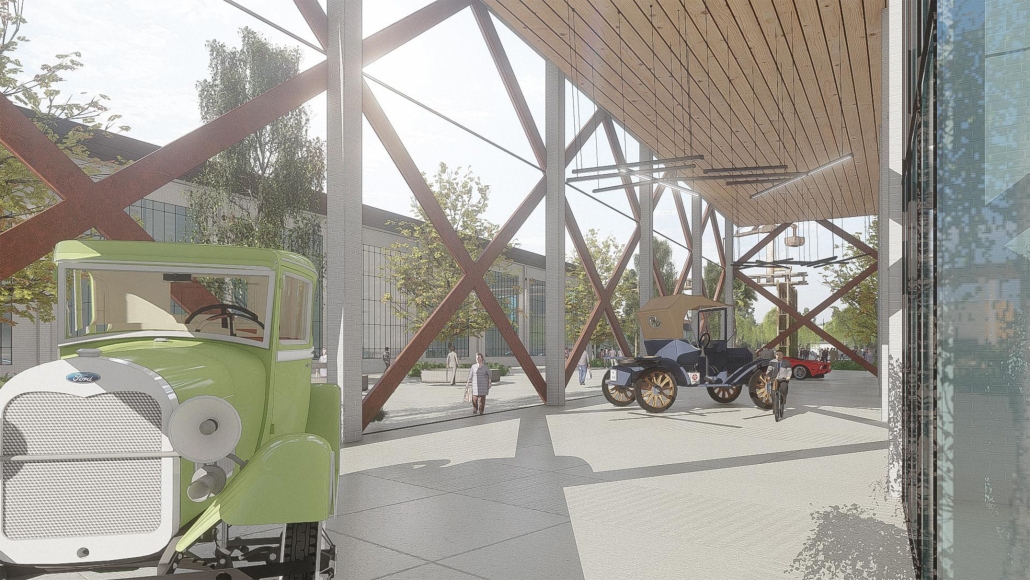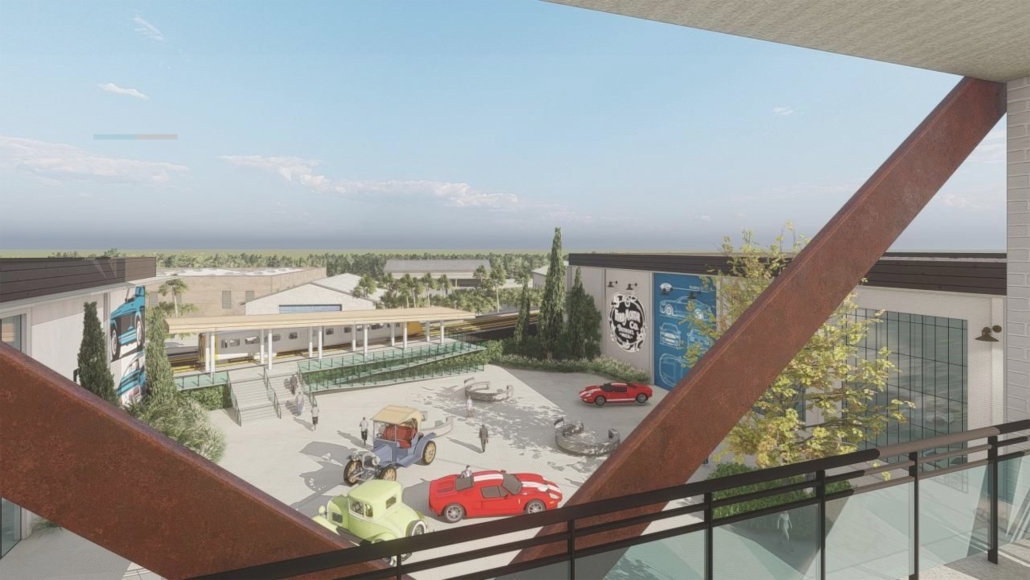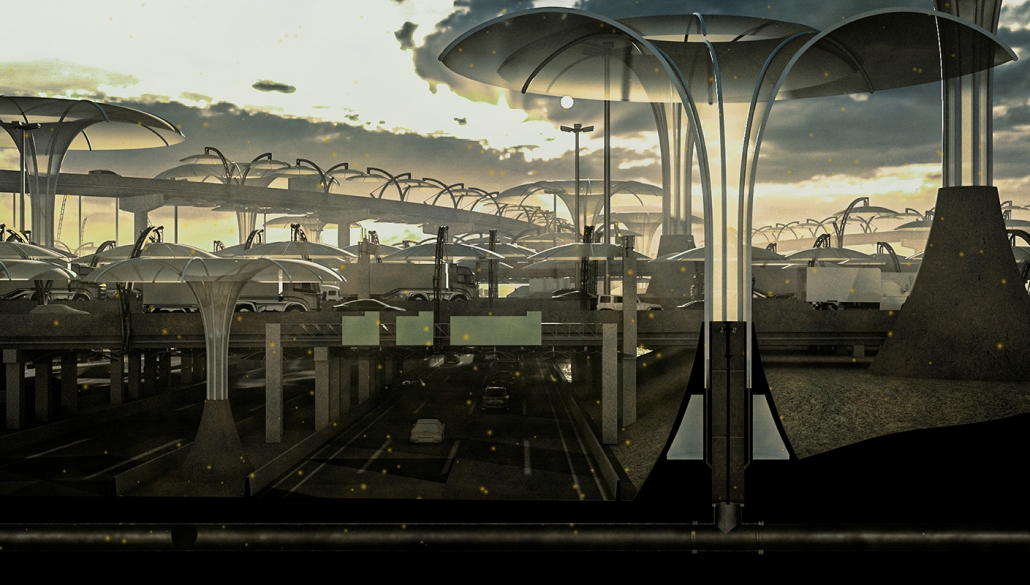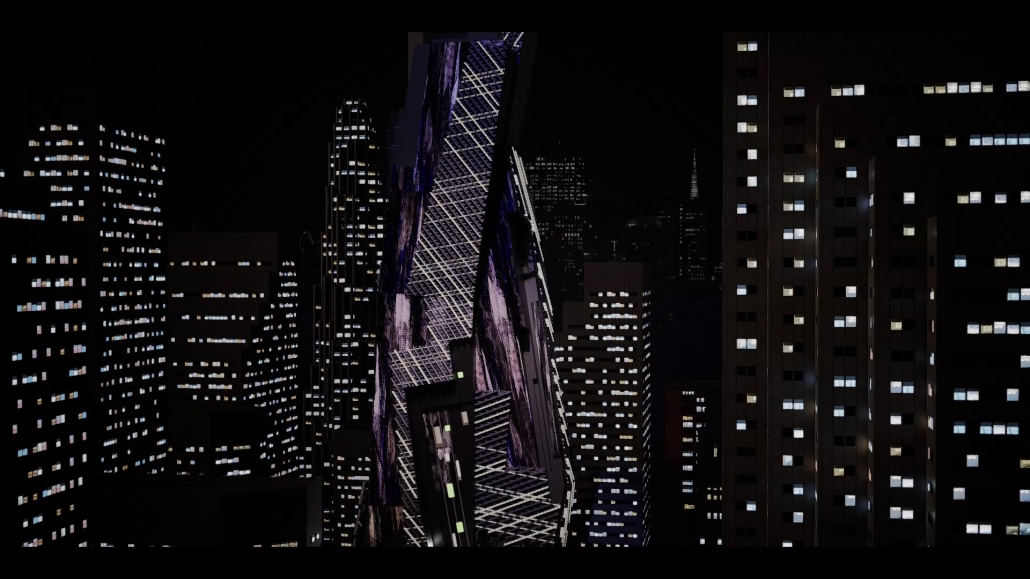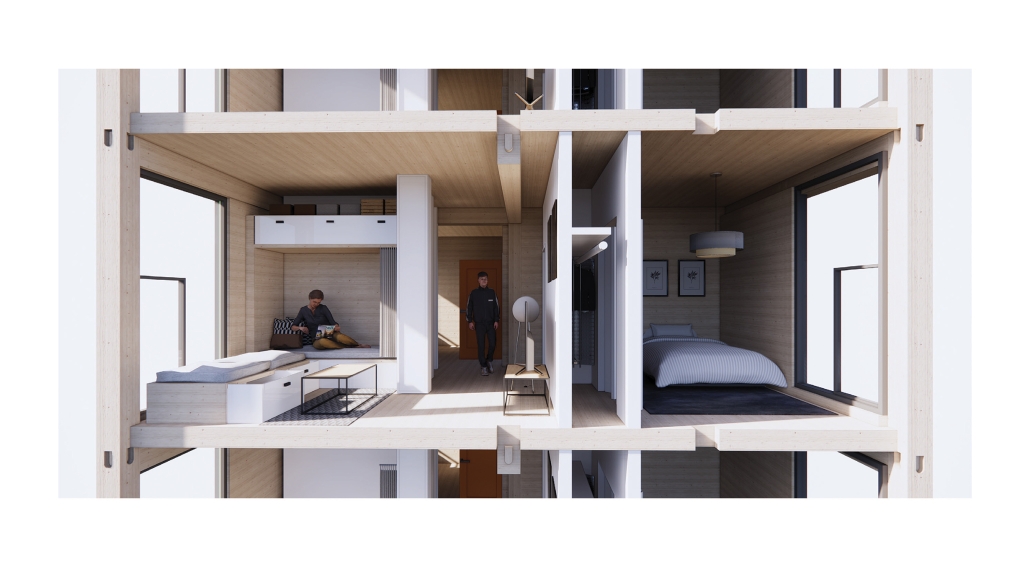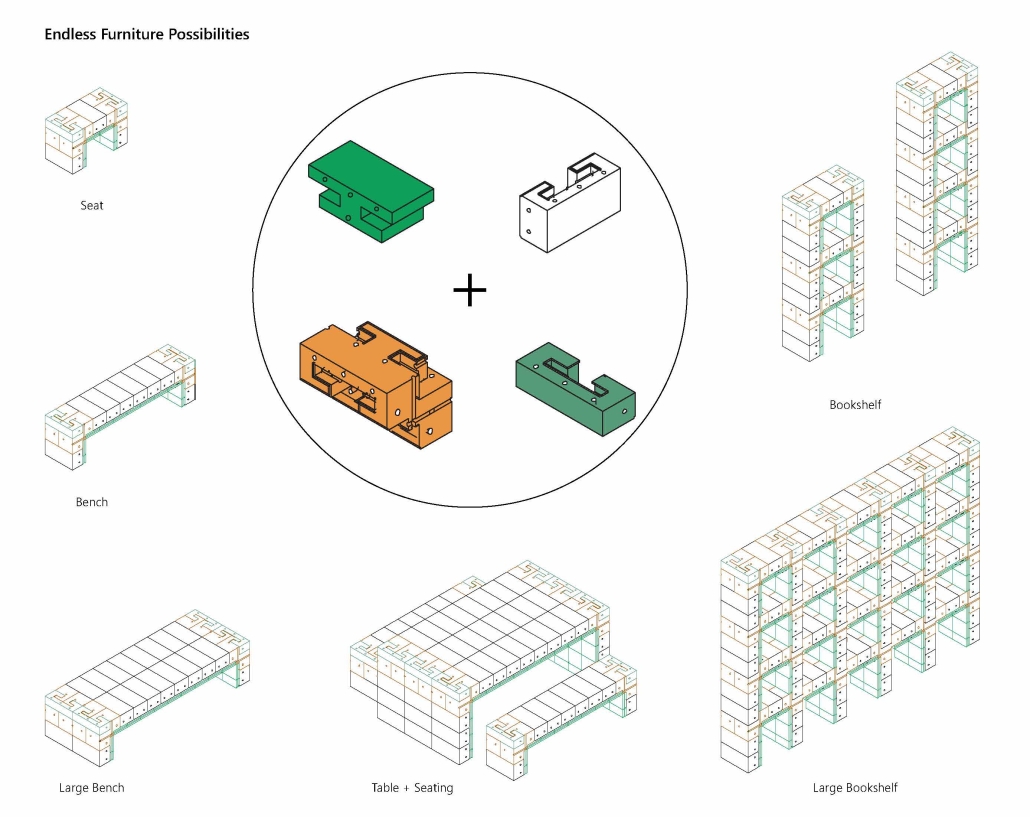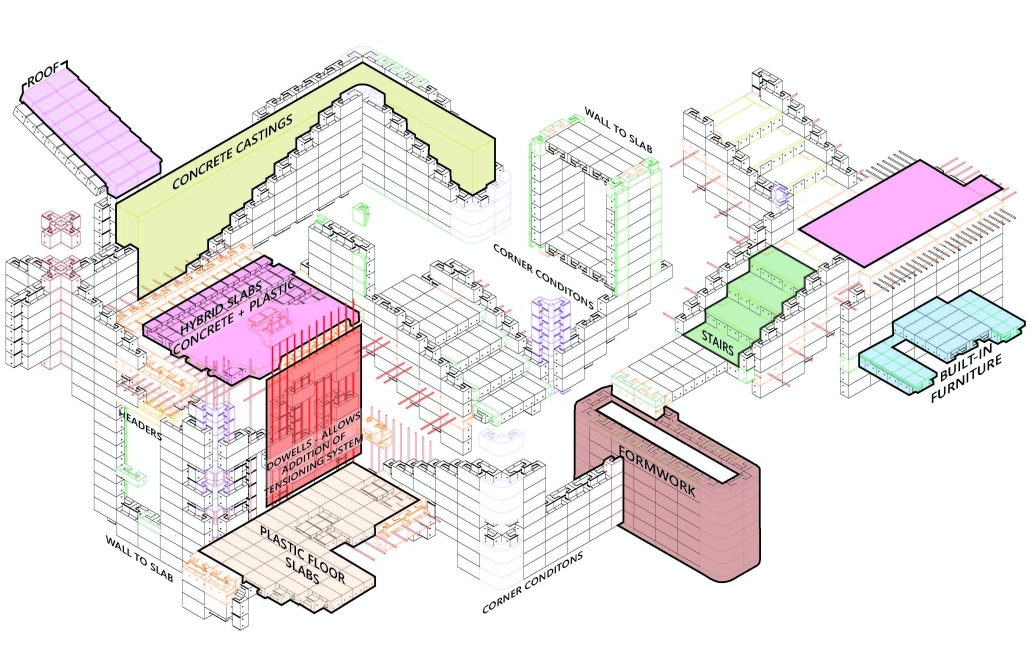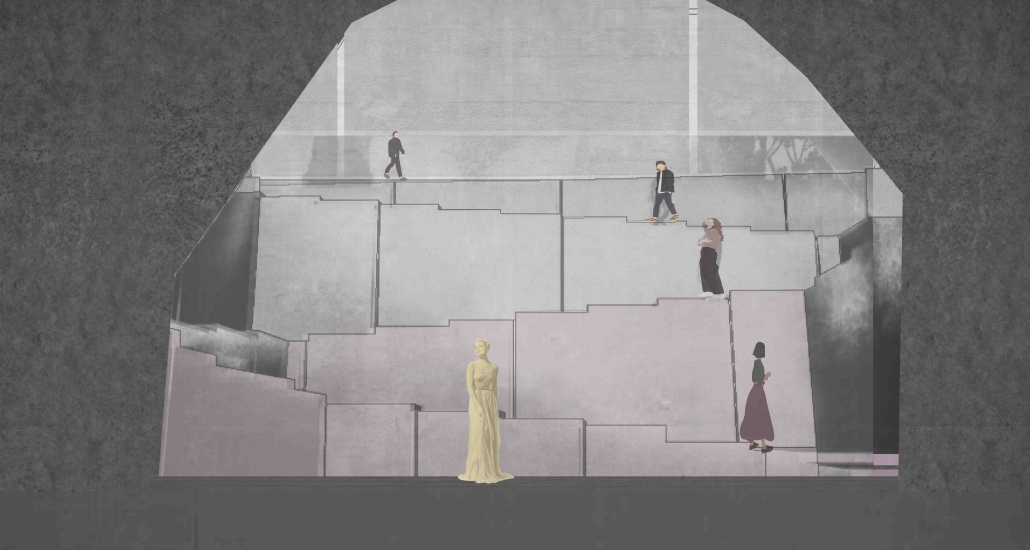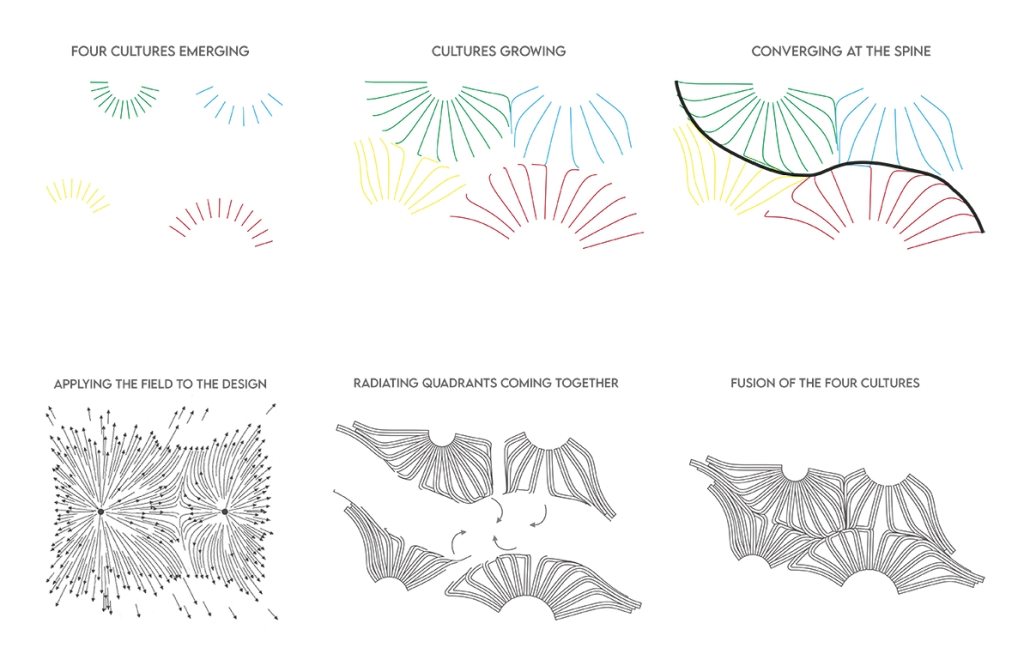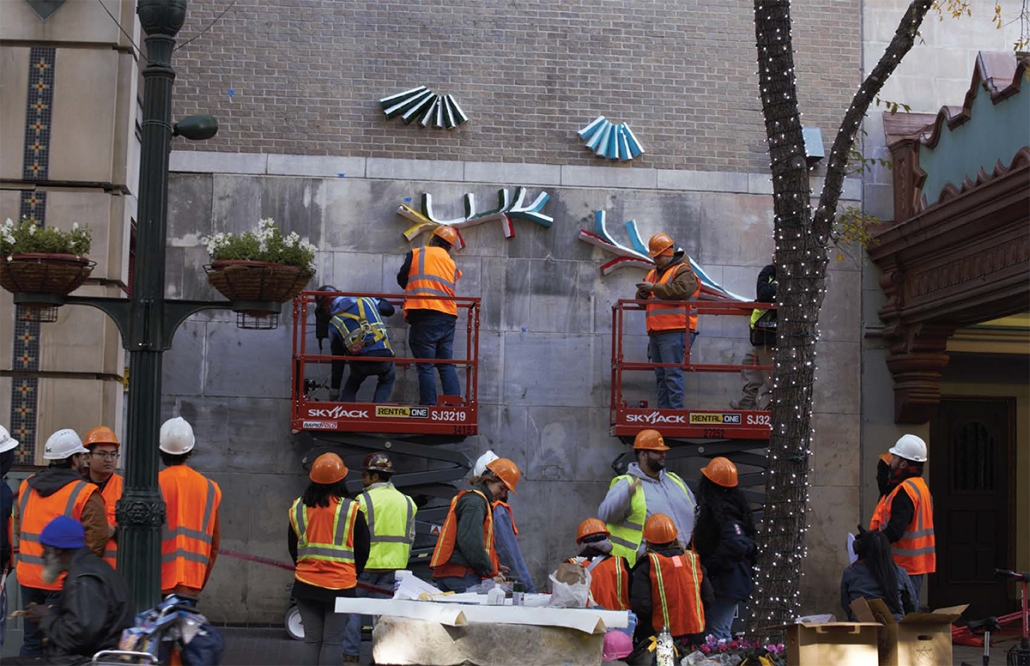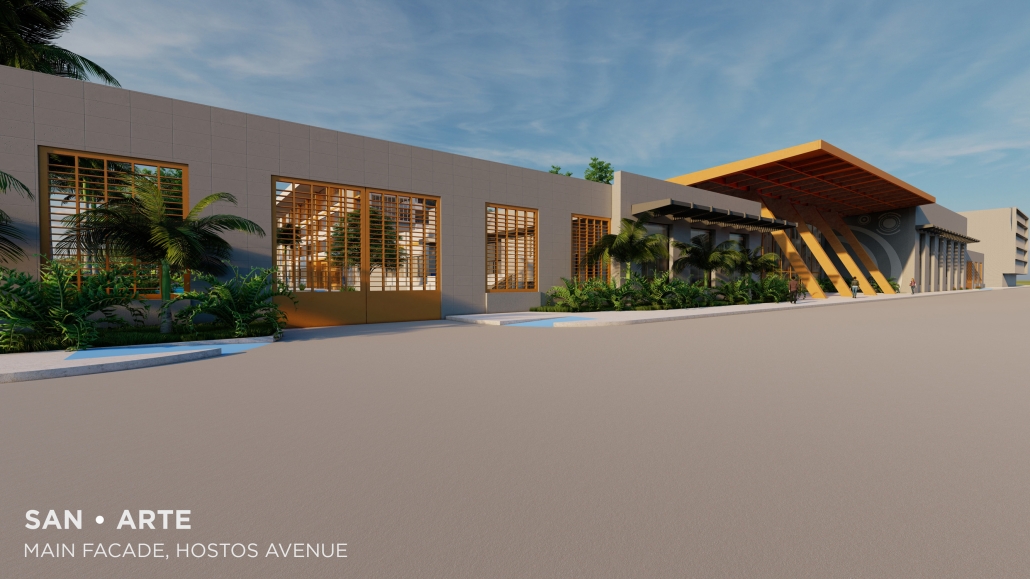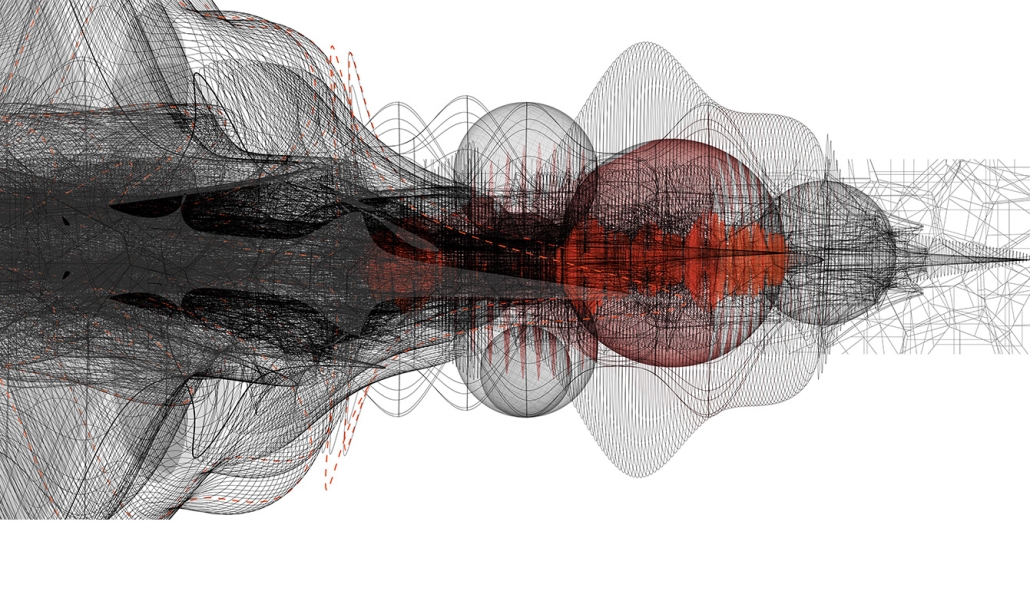Posts
Study Architecture Program Spotlight: Tulane University’s URBANbuild Program
As an architecture student, you have the opportunity to access various programs that will expand your skills and provide you with hands-on experience. At Tulane University, URBANbuild is an award-winning design-build program that allows students to gain firsthand experience building homes in their local community in New Orleans, Louisiana.
The program was founded in 2005, with plans to launch that fall semester. However, the city of New Orleans was devastated when Hurricane Katrina made landfall later that August. Hurricane Katrina was one of the deadliest and costliest hurricanes in U.S. history. According to URBANbuild’s website, “the city was left 80 percent damaged with the population immediately reduced to one-third.”
 (Image Credit: Tulane University)
(Image Credit: Tulane University)
“[Hurricane Katrina] really messed up our plans to start this new program, but more importantly and more rewardingly, it gave our program a new mission,” said Byron J. Mouton, Senior Professor of Practice at the Tulane University School of Architecture and Director of URBANbuild.
As New Orleans prioritized rebuilding, URBANBuild shifted its gears to not only assist in revitalizing the city but to also address New Orleans’ pre-Katrina problems including hesitancy to accept change. “When we first stepped into these communities, they were hesitant to buy into what we were doing,” said Mouton. “But then the second year came around and we returned and they were a little more receptive. And then it wasn’t really until we were there for three or four years that the community felt comfortable enough to engage with us.”
Community engagement and involvement is one of the most important qualities of URBANbuild. The program partners with local organizations including Bethlehem Lutheran Church, the Neighborhood Housing Services of New Orleans (NHS), and Urban Fabric. “We had to build that trust,” explained Mouton. “We also worked with an organization called Neighborhood Housing Services, which had been around before Katrina, and they specialized in helping people find ways to get homes. They were really the great connection between what we were doing as researchers and what the community needed.”
The URBANbuild program spans the fall and spring semesters, offering students the opportunity to engage in the home-building process from concept to construction. The fall semester focuses on planning and research. Participating students are tasked to investigate housing strategies, permitting regulations, drafting construction documents, the cultural fabric of the community, and other key considerations.
“[During the fall semester,] we get together with the students and we have a little in-studio competition. We identify our topic of research. They each develop a strategy, and then one is chosen. They select one at midterm, and then they work on the construction documents between midterm and the end of the semester,” explains Mouton.
Students get hands-on building experience as they begin the construction process during the spring semester. “We break ground in January of the spring semester and build the house by May,” Mouton continues.
(Image Credit: URBANbuild)
Over the span of 16 weeks, students learn construction techniques, communicate with tradespeople, and watch their project come to life. “[The students don’t come in with construction experience], but they do have the desire to learn and they work hard,” says Mouton. “And to be clear, they do everything except I have to hire an electrician, a plumber, and an air conditioning consultant installer. And then once in a while I’ll have a crew hang the sheetrock, but they do everything else.”
By the end of the semester, students are able to celebrate the product of their research, construction, and teamwork: a fully built home. Finished projects include tiny houses, single-family homes, duplexes, mixed-use facilities, and more.
According to UrbanBuild’s website, it’s during the spring semester that students develop strong bonds with the community’s residents. “Getting to work with NHS, I got to know the family [we worked with] very well, and I’ve been able to visit them years after,” shared URBANbuild alumna Karla Valdivia. “It’s great to get to know the family because you are creating something that really affects them. It has a very personal feel.”
Recently, URBANbuild garnered national attention when the program was featured on CBS News. Aired in October 2024, the segment highlighted 63-year-old Benjamin Henry moving into his new home, thanks to the work of Tulane students. In four months, the students transformed a vacant plot of land into Henry’s “forever home.” Formerly unhoused for over a decade, Henry shared his excitement for the new chapter and expressed his heartfelt thanks to the students. “Building someone’s forever home is crazy and so rewarding,” said Tulane graduate Elliot Slovis.
Graduates of the URBANbuild program have gone on to become licensed architects and designers. They credit the program for providing them with an in-depth understanding of the construction process and emphasizing the importance of community engagement. “[URBANbuild] gives you the real-life experience of what life is like after school,” shared Valdivia.
Design-build programs like URBANBuild are a great way to expand your skillsets and gain real-world experience before graduation. Visit the URBANBuild website to learn more about the program, browse the curriculum, and view finished projects.
Interested in learning more about Tulane University’s School of Architecture? Click here!
Questions about the URBANbuild program? Please contact Byron Mouton (bmouton@tulane.edu).
2024 Study Architecture Student Showcase - Part XIV
Architecture plays a large role in the restoration and preservation of buildings. The projects featured in Part XIV of the 2024 Study Architecture Student Showcase focus on revitalizing spaces.
Today, we look at various sites, including areas impacted by natural disasters, former industrial zones, federal buildings, and more. Each project blends old and new, demonstrating the ability to recover and reclaim using architecture and design.
Reclaiming Antakya: Post Disaster Community Recovery for Resilient Futures by Zeynep Dila Demircan, M. Arch ‘24
University of Maryland | Advisor: Ken Filler
The earthquakes that struck Southwestern Turkey and Northern Syria in February 2023 caused extensive damage, ranking among Turkey’s worst disasters in its history. The city of Antakya, especially, suffered severe destruction in its center, resulting in significant losses of lives, culture, and history.
This thesis presents a comprehensive plan to recover and reclaim Antakya’s center, enhancing community resilience through proactive design strategies. It focuses on a specific urban block, a key commercial, residential, and administrative hub across the Asi River and the historical district. The proposal outlines a multi-phased approach to transform this urban block, starting from the post-disaster period and concluding with its complete redevelopment. The phases include recovery, reclamation, reconstruction, and reconnection.
For the recovery phase, temporary shelter and gathering spaces are provided for residents within the grove area existing on the site, while efforts to engage stakeholders in the recovery process begin. Reclamation involves reforming the cleared area based on existing and new street systems, integrating new public streets and courtyards that make up the green infrastructure. Reconstruction involves rebuilding the site in smaller blocks, starting from the middle section and expanding to the upper and lower sections. The reconnection phase focuses on finalizing building blocks and reintegrating them into the larger context.
This includes the creation of a new urban plaza and the introduction of programs aimed at fostering cultural and social resilience, as well as commemorating the earthquake through a memorial space within a community center. The proposal introduces two main building types: The Block, a mixed-use structure with a courtyard for residents, and The Hub, a community center featuring public spaces, a museum, gathering areas, and studios for local crafts practices.
In essence, this thesis aims to not only reconstruct Antakya’s physical infrastructure but also to cultivate resilient communities through place-making strategies. It endeavors to revitalize cultural and social life while fostering trust and collaboration, ultimately laying the groundwork for a robust and resilient future.
This project won the UMD Architecture Thesis – Director’s Award and the ARCC 2023-2024 King Student Medal for Excellence in Architectural + Environmental Design Research.
The Topographical Reactivation by Yanbo Zhu, M. Arch ’24
University of Waterloo | Advisors: Mohamad Araji & Shiyu Wei
Community Center Design at Kitchener
This design features three keywords: nature, history, and topography.
- NATURE: The site is located in the center of Kitchener, with the expansive Victoria Park to the south. However, due to roadways and parking areas interrupting the flow, it’s challenging for this landscape to permeate the site effectively. Simultaneously, with a site area of 15,000 square meters and a required building area of only 1,500 square meters according to the project brief, the strategy involves integrating small-scale structures with the landscape to address the issue of the site’s excessive scale.
- HISTORY: Within the site, there is an abandoned Charles bus terminal, with its main hall building well-preserved, but the historical elements of its platforms, bus lanes, and connecting corridors are poorly maintained. In the design, preserving the original waiting hall while removing other elements yet continuing its multi-linear spatial configuration is a critical historical stance.
- TOPOGRAPHY: On the eastern side of the site, there is an elevation difference of nearly four meters. In the design, a planted roof is utilized to seamlessly connect, allowing individuals to enter the building from the roof. Simultaneously, the height difference is employed to create outdoor stepped activity areas or sloped gardens. Additionally, to respect historical architecture, a partial sunken approach is employed in spaces like the art gallery and lecture hall, forming various topographical experiences.
This project won the Edward Allen BTES Award and the Second Prize SOPREMA Award.
Instagram: @yanbo_zhu
Amending the Capitol by Garrett Krueger, M. Arch ‘24
Virginia Tech | Advisors: Susan Piedmont-Palladino, Paul Emmons & Scott Archer
The United States Capitol Building has long been an iconic symbol of the American government and democracy worldwide. Despite this, the United States has had many major events since 1892, and the Capitol has not had any representation of those events.
One example of stalled symbols of change is the number of representatives in the House. Since 1913, the House of Representatives in Congress has had 435 representatives, despite the population more than tripling since then. Many have had the idea to increase this number and expand the House. This idea gives an opportunity to design a new, larger chamber for the House to meet in. This thesis proposes a new chamber to redefine the architecture of the Capitol Building and symbolize the century of history that has yet to be represented in the Capitol.
The idea of making a new expansion to the iconic Capitol Building comes with challenges. This thesis was done amid historic turmoil and record lows in productivity in the House. This thesis also begs the question of whether the building that Congress meets in can be part of the solution. The House Chamber, when completed, had no electric lighting, let alone C-SPAN cameras and smartphones in every lawmaker’s pocket. This new extension aims to provide Congress with a workplace designed to address the difficulties it faces in keeping itself in order. As a whole, this thesis is about the idea of representing change. The nature of a democratic government is one of changing ideas and laws, and this project seeks to have the Capitol Building embody that aspect. Thomas Jefferson himself is known for saying rejecting change is like “requiring a man to wear still the coat which fitted him when he was a boy.” Congress needs a new coat.
This project won the WAAC Crystal Award.
Instagram: @vt_waac
Life, Death, and the Eternal Recurrence of Architecture by Geri Roa Kim & Kelvin Hu, B. Arch ’24
Pratt Institute | Advisors: Adam Elstein, Frank Gesualdi & Ashley Simone
Life, Death, and the Eternal Recurrence of Architecture proposes building anew as a form of preservation. Situated along the Arakawa River Island in Tokyo, this project is a story of a building that has grown over time since 1946. The building undergoes successive replication and revision every few years, each edition is built next to its predecessor, eventually becoming an endless, linear, horizontal skyscraper that constantly reinvents itself through time.
This architectural approach, rooted in preservation, provides a tangible way to experience changes that normally unfold over centuries. Architecture, then, becomes a device to register time.
This project won the Best Degree Project of 2023/2024.
Unbound Beirut: Reimagining Boundaries & Transforming Realities by Sima Fayad, B. Arch ’24
American University of Beirut | Advisor: Makram Al Kadi
This architectural thesis culminates in transforming Beirut’s iconic dome, The Egg, located in Solidere, into a multifaceted public space. It seamlessly integrates medical, educational, and cultural uses through a harmonious fusion of virtual and physical elements. This design transcends Solidere’s boundaries, fostering interaction among diverse user groups within a dynamic environment. Symbolizing Beirut’s resilience and revival, The Egg blends history with a vibrant future, redefining spatial inhabitation by bridging physical and virtual realms.
At its core, this thesis explores the intersection of physical and virtual spaces, emphasizing the enduring significance of tangible structures while delving into the growing realm of digital environments. It investigates how architects can utilize digital technology to craft emotionally and socially resonant spaces that transcend traditional boundaries. Envisioning a future where architecture integrates seamlessly with digital elements, the study challenges architects to reimagine spatial design.
The introduction lays the foundation by recognizing the pivotal role of physical spaces in our spatial understanding, positioning the thesis at the confluence of the tangible and intangible. As digital technologies increasingly influence our physical reality, this thesis calls on architects to incorporate digital elements such as virtual reality and internet connectivity into their designs. It highlights how these once futuristic concepts are now essential tools for creating visually striking, functional, and socially impactful architectural spaces.
The thesis examines the redevelopment of Beirut’s downtown area, specifically focusing on The Egg, a striking dome in the Solidere district. This site symbolizes Beirut’s resilience and revival post-war, embodying the city’s enduring spirit while highlighting the economic barriers that modern urban landscapes can create. The Egg stands as a testament to Beirut’s cultural heritage, illustrating how architecture can blend the past with a vibrant future, bridging physical and virtual realms to redefine our concept of inhabiting space.
Instagram: @ard_aub
PENINSULAR PAPER CO. by Chase Dietrich, B.S. Arch ’24
Lawrence Technological University | Advisor: Masataka Yoshikawa
The project, PENINSULAR PAPER CO., began with an in-depth site analysis. The design was initially inspired by the natural gathering spots surrounding the existing building. This project aims to renovate and expand the existing structure, guided by the logic of these natural gathering points and the acute angles they form. The contemporary vision for the building’s renovation leverages these convergent points, ensuring the new design seamlessly integrates with the environment while enhancing functionality and aesthetic appeal. By focusing on these natural elements, the project promises a harmonious blend of old and new, creating a revitalized space that respects its historical context and serves modern needs.
This project won the Lawrence Technological University Chair’s Award.
Instagram: @chase.a.dietrich, @masataka.yoshikawa
Steamtown Revival by Mason Ramsey, James Gentilesco & Dalton Metzger, B. Arch ’24
Marywood University | Advisors: Jodi La Coe & James Eckler
The Joseph Biden Presidential Library uses various design concepts to best represent our president’s values. Green walls, aquaponics, water reuse, and bioswales all work together to visually demonstrate President Biden’s environmental priorities. These are new concepts for the proposed site in Scranton, Pennsylvania, currently occupied by the Steamtown Mall, a development that only hurt the economy and environment of the city, as Jane Jacobs argued. The entire site is to be replaced with biking and walking trails to best integrate the cityscape with nature. Inside this presidential library, one may visit Biden’s museum collection, browse through his personal selection of books, and even request access to presidential archives in this new landmark in a regrowing city.
Instagram: @ramsey_architecture, @gentilesco_architecture, @jodilacoe
“Navigating Uncertainty” in Lebanon by Karly Abou Dib, B. Arch ’24
American University of Beirut | Advisors: Trevor Ryan Patt & Rana Haddad
“Navigating Uncertainty” embarks on a detailed exploration of oil terminals, delving into their structural intricacies and temporal dimensions. By examining the historical significance, contemporary functionalities, and future uncertainties of these terminals, the study unfolds a narrative that seeks to craft a transformative blueprint for their decommissioning and sustainable future.
At the heart of this exploration is the concept of transforming challenges into opportunities for innovation through human collaboration. The uncertainty surrounding oil terminals is reimagined as a productive force, driving the evolution of a resilient and environmentally conscious infrastructure. The study proposes a shift from impermeable industrial containers to porous courtyards or “voids” that invite nature to reclaim and transform these spaces. This transformation symbolizes a transition from industrial to ecological, where past structures are enveloped by greenery and become communal spaces that foster biodiversity and community interaction.
Strategically designed “solids” are introduced within these voids, serving as eco-friendly program holders that benefit the environment. These solids house activities such as labs and workshops, green markets, and human energy-powered gyms, directly engage with and enhance their natural surroundings. The design and proportion of these solids vary based on their environmental impact, with programs that have a significant positive effect on nature occupying more prominent spaces.
The interface between the new solids and the voids is filled with community engagement opportunities and pathways that foster educational and cultural experiences. Visitors navigate through these transformed spaces, engaging with layers of information and activity that promote a deeper understanding of sustainability and its impact. This dynamic environment educates and inspires, cultivating a greener mindset among its visitors.
The project transforms an industrial site into a vibrant green space through the development of a porous wetland. This wetland enhances social well-being, supports biodiversity, and aids in natural water treatment and flood mitigation. It serves as an educational hub promoting environmental sustainability and highlights the role of wetlands in urban ecosystems. By integrating water into the site, the wetland mitigates flood risks and improves urban microclimates, showcasing how industrial areas can be reclaimed by nature
Instagram: @ard_aub
Global Educational Center for IT Specialists and Migrants in Istanbul by Anatolii Savoskin, Diploma in Strategic Interior Design / Private Master Degree ’24
IE University | Advisor: Elvira Munoz
For my graduate project, I tackled the challenges faced by skilled migrants, drawing from my own experience and that of friends worldwide. Using design tools, I aimed to provide solutions by identifying a real client in crisis and repurposing an underused building. Researching the client’s needs and challenges was pivotal in shaping our design strategy. We chose a historic building in central European Istanbul, strategically located near public amenities and transportation hubs to cater to our target audience: migrants with IT backgrounds. Detailed user mapping helped to understand their expectations and needs. My design concept focused on four key elements: an Al educational center, a rebranding campaign for Blackberry, integration of multicultural design elements reflecting migrants’ cultures, and a transition from classical to modern styles throughout the building’s floors.
Instagram: @iearchdesign, @anatolii_savoskin
Extending The Patchwork | The Pier by Jillian Sproul & Olivia Nunn, M. Arch ’24
Toronto Metropolitan University | Advisors: Joey Giaimo & Julia Jamrozik
Located in Old Orchard Beach, Maine, a tourist beach town, the project proposes an extension of the current pier providing opportunities for vendor expansion. The new pier proposal is achieved through the implementation of subtractive and additive heritage strategies. It provides locals with the agency to expand their business onto the structural modules that will aggregate as needed based on future growth, extending the existing vendor and architectural patchwork. The existing main pavilion has been opened up as a midpoint for resting and [eating]. The newly designed end pavilion embraces the past entertainment values of the site, showcasing live performances and expansive views out to the water. The form of the performance structure is shifted to align with the main street of the town, inviting visitors to adventure through the entirety of the pier, especially during sunset, when sun rays reflect off of the metallic panels. The two-storey performance pavilion is accessible with the feature ramp leading tourists on a journey separated from the busy vendor stalls. The total pier addition allows the current architectural and vendor patchwork to be valued as a key component to the pier’s long-standing success since 1899.
The physical model utilizes three types of wood to visualize the architectural patchwork of the current pier and the proposed extension. The burnt maple represents existing components of the pier, while the cherry represents existing components that have undergone renovations. This is contrasted with the basswood that represents the proposed patchwork extension.
Instagram: @jilliansproul, @olivianunn14
Reshaping Red Hook: Creative Placemaking and Connective Infrastructure. by Matthew Tepper, B.S. Architecture ’24
University of Virginia | Advisor: Mona El Khafif
From a manufacturing and transporting port to a refined and vibrant community hub, the masterplan analyzes the demand to unify the Red Hook, Brooklyn neighborhood to its adjacent post-industrialized, underutilized waterfront. It looks at a series of 19th-century waterfront warehouses as a symbolic reference to its connection with shipping and connectivity within the New York Harbor and a dilapidated water’s edge to activate opportunities for public engagement and hospitable, engaging programming.
Red Hook, named by the Dutch in the 17th century, references its red clay soil and brick construction methods, as well as its jutting peninsula forming into the Upper New York Bay. In the late 19th century, Red Hook was the busiest freight port in the world, serving as the center of the city’s cotton trade. Later on, with the rise of Robert Moses, the Gowanus Expressway and the Brooklyn–Battery Tunnel were built in the 1940s, followed by the first federally funded public housing projects in New York City. While Red Hook’s socioeconomic status declined due to a decline in maritime trade and employment access, its economic outlook is rising again as new businesses, artists, and artisans are beginning to bring vitality.
The program explores indoor, outdoor, and interstitial moments as means for a creative ecosystem, expanding a sense of connectivity through the Cobble Hill Tunnel within neighborhood bounds. The Cobble Hill Tunnel, the oldest tunnel in New York City, was rediscovered in the 1990s after being inactive for over 120 years in Downtown Brooklyn. It was imagined to stretch to Red Hook but was never fulfilled. In reimagining the existing lack of public infrastructure within Red Hook, this physical and symbolic representation would allow for connectivity across Red Hook while recognizing the neighborhood’s rich history.
Forming an experiential approach to this connectivity aims to foster and maintain local, community-driven growth. The proposal intends to re-establish the water’s edge with a realignment of the existing Red Hook gridded organization and shift vehicular traffic to prioritize pedestrian experiences and modes of public transportation. To enable economic incentives for development, existing two-story warehouse buildings will expand upon their mass-timber structure as an extension of contemporary mass-timber building codes to provide a relationship between working and living environments. The existing parking lot will transform into Red Hook’s public square to support local artists, and a central amphitheater will serve as the concluding nexus of the tunnel. These transversal relationships can ensure dialogue between above- and below-ground environments as a new typology for untapped programming and real estate investment.
Instagram: @mattportfolio, @aschool_uva
Fluid Landscape: A Speculation on Edge by Marla Stephens, M. Arch ’24
University of Florida | Advisors: Charlie Hailey & Jeff Carney
Architecture for a Fluid Landscape: A Speculation on Edge, addresses the ephemeral nature of dwelling on Florida’s coastal edge. This project aims to unearth Florida’s fluid strata to resurface a forgotten timeline of architectural ruins and stories lost at sea and to reinterpret future coastal habitation for an accreting landscape. Using Wilbur-by-the-Sea and Cape Canaveral, Florida as stations for witnessing and recording the evolution of an edge, this project will begin to negotiate the nature of impermanence and symbiosis of architecture along the shore.
As time passes, layers of stories, artifacts, ecologies, and technologies are embedded within the anthropogenic landscape. Is time as fluid as the littoral edge? Is there a way to work between the layers, to establish a permanent marker of change, to record the unfolding of time on an uncertain edge? Time moves quicker and shorter here, each day is a different coast. On the edge, change is felt at a more alarming rate. Here we bear witness to the ecological impact we have made; impacts which are felt slowly, suddenly, or all at once. Can architecture make us notice more? Notice the imprint of a seashell along the shore, and the fluttering of the saturated sand made by a sand flea hiding beneath the surface; to the detrimental effects of toxic runoff which tarnishes the shore with a nauseating green film, and the infrastructural damage inflicted by hurricanes and rising tides. We must notice more, to slow down time once again and decelerate our current path towards exponential degradation, to restore Mother Nature’s natural procession.
This project will collect and unearth objects and stories found along the fluid landscape while using the Florida Houses of Refuge as a generative part for testing markers on the coast. The Houses of Refuge were ten stations along the east coast of Florida constructed for the sole purpose of saving the lives of shipwrecked persons, yet they evolved into much more. This project uses the forgotten coast of Chester Shoal as a proving ground for ever-evolving iterations of stations that witness the transformations of an ephemeral landscape.
Instagram: @charlie.hailey, @marla.stephens
Conservatory of Theater: A Spot Light in the User by John M. Campis-Bobe, B. Arch ’24
Pontifical Catholic University of Puerto Rico | Advisor: Pedro A. Rosario-Torres
The decline of performing arts in contemporary culture can be attributed to a lack of cultural identity. Historically, theater served as a platform for societal reflection and discussion of political and sociocultural issues. Today, this art form has lost its prominence in many countries, necessitating a revival to inspire a new generation. To address this, the project employs the concept of a perfect prism to contrast its surroundings, highlighting the performance space as a vital expression of cultural identity.
Located in Bayamón, Puerto Rico, near the urban train’s last station, the project identifies existing entities and highlights those proposed for improvement. By linking the urban core, it establishes a new theatrical district with an axis running from the town hall through Marti Street to the Theater Conservatory. The conservatory’s design incorporates six strategies from modern theater culture, seamlessly integrated into the urban context, emphasizing both external and internal engagement. Its purpose is to create a series of encounters between performances and spectators, inviting exploration and contemplation throughout the city. For example, urban niches carve fenestration within each façade, showcasing rehearsal rooms, foyers, and terraces to residents and visitors passing by. The black box theater is cantilevered from the building façade, marking the culmination of the theatrical district axis. Inside, there are adaptable spaces for various scenarios that aren’t restricted by a fixed arrangement. This expands on the versatility to reconfigure to the constant changes in our contemporary culture. To improve the user experience and accessibility, an elevated urban plaza is created, bridging the conservatory with the surrounding urban fabric and inviting community interaction. Due to the tropical climate, sustainable features include natural ventilation on all floors, permeable pavement, solar panels, and an underground cistern for water storage.
The final model reveals the axis that unifies the new theatrical district and an alternative route from the train station, designed to enhance pedestrian access. By integrating urban connectivity, cultural engagement, and sustainable design elements, the conservatory sets a new standard for functionality and environmental stewardship, marking a transformative icon for new cultural expression.
Instagram: @johncampiss
Archi-eulogy: Negotiating Ruination in the Urban Void by Glory Nasr, B. Arch ’24
American University of Beirut | Advisor: Sinan Hassan
In a dense alleyway of a residential suburb of Beirut, Lebanon, lies a neighbourhood-sized construction site, halted at the excavation stage. Where once stood the Laziza Factory, the first brewery in the Levant that was demolished in 2017, remains a 20-meter-deep manufactured chasm, vestiges of the unfinished construction of a high-end, Starchitect-made residential project. The chasm resembles a tomb with no capstone, a tomb for the demolished brewery and the immaterialized lofts, but more importantly for the notion of architecture as a practice above the human realms of economic crisis. The result is an absurd condition caught between architecture, geology, and ruin.
With this urban condition as the site of the project, Archi-eulogy stands as a manifesto
critiquing the method with which we build, developing an architecture that is inherently one of nonarchitecture. Building on the image of the site as an urban tomb, Archi-Eulogy proposes the acceptance of death through a lowering of a literal and metaphorical capstone onto the construction site over a 100-year cycle, corresponding to the average lifespan of a building. The capstone houses an art gallery and archival space, preserving the memory of the original brewery. Each height above the street level corresponds to a year, creating a geological stratification of the building height. As the capstone descends 0.5 cm a week
for a century, matter accumulates and decumulates in the pit. The pit houses a parking space on the upper two floors, while the bottom three floors are left as public space for the residents of the neighbourhood. Once the capstone closes and the excavation is remediated, the project enters its second phase, becoming a curated ruin-scape, allowing for informal uses of the public park. Finally, hundreds of years into the future, archaeologists descend into the pit through its towers, exhuming the archaeological body buried in the tomb. By literally and metaphorically closing the urban tomb, the project aims to remediate the violence the unfinished construction inflicted on the neighborhood.
This project was the 2nd Prize Winner of the Areen Projects Award for Excellence in Architecture and won the Dean’s Award for Creative Achievement.
Instagram: @ard_aub
Stay tuned for Part XV!
2024 Study Architecture Student Showcase - Part XIII
Public spaces take the spotlight in Part XIII of the 2024 Study Architecture Student Showcase. The featured projects include recreation centers, parks, memorials, performance spaces, multi-faith facilities, city centers, and more!
Each student’s design was crafted with community needs at the top of mind. They utilize strategies ranging from reducing height in response to residential locations and combatting hostile architecture. They are also intentional about the use of materials with mediums such as wood, steel, and glass playing a role in curating the visitor experience. Each project aims to promote equity, education, belonging, socialization, and connectedness within their communities.
Scroll down to view these inclusive, accessible, and vibrant public spaces!
Tarboro Road Recreation Education Center by Lucas Stott, B. Arch ‘24
North Carolina State University | Advisor: Marshall Purnell
Compelled to provide vital community forums, recreation, and green spaces to East Raleigh, the 30,000-square-foot Recreation Education Center (R.E.C.) has created a gathering location for residents while linking local neighborhoods to Raleigh on a broader scale.
E. Edenton St. and New Bern Avenue have become defining features of East Raleigh, bringing in a surge of traffic from Downtown Raleigh. This results in a corridor of commercial properties and roadways that divide low-income neighborhoods. R.E.C. uses its visibility of these high-traffic roads to revitalize the region.
R.E.C.’s L-shape shields the neighborhood, opening towards the local community and protecting it from the intruding larger-scale city. Two diaphanous frames visible from the intersection attract new visitors intriguing fresh faces that would otherwise never visit the region. The existing historical educational building, converted into a 200-seat event hall, encourages public forums and community-building, breaking down barriers that traditionally separated East Raleigh from the rest of the city.
Commercial spaces and community resources are organized separately into two elevated frames, with an atrium acting as the convergence point and entry. The first frame, a 24-foot deep truss, suspends across the landscape, revealing the commercial gymnasium and activity spaces it protects. Ramps down to the gym address difficult topography to reduce the R.E.C.’s height in response to its residential context. The second frame floating over the atrium provides vital educational resources to the underprivileged community, fostering skill development to improve employment chances in a rapidly transforming economic landscape. Curved aluminum panels coating the floating frames are perforated with a pattern that interacts with light and shadow, creating a unique experience.
The north end of the site is grafted into the neighborhood’s skin. The form tilts open to reveal an outdoor space optimized to bring in local pedestrian traffic, encouraging residents to treat it as their backyard. Enclosed between the building and forested paths on the north side, a large open court becomes an important anchor on the site, freely defined by community-organized events and activities.
This project won a 2024 AIA Triangle Student Design Award.
A Hostile City, Inequitable Privatization of Public Spaces by Bailey Berdan, M. Arch ’24
Lawrence Technological University | Advisor: Scott Shall
Hostile architecture is a term used to describe design strategies that are intended to deter certain groups of people or behaviors in public spaces. While bench dividers and ground spikes are widely recognized examples of hostile architecture, their impact goes beyond these small-scale designs. Hostile architecture is pervasive in areas such as policy, law, and privatization, and it can have serious negative consequences on a community’s economy, walkability, and overall environment.
To address this issue, one potential solution is parasitic architecture, which is a practice that is not commonly used but is often employed as a response to dysfunctional conditions. Parasitic architecture involves the creation of structures that are attached to or embedded within existing buildings or infrastructure, utilizing underutilized or overlooked spaces. This approach has the potential to combat hostile architecture and empower communities to reclaim their right to public spaces.
By repurposing underused spaces, parasitic architecture has the potential to increase the availability of public spaces, reduce the costs of new construction, and foster a sense of community ownership and engagement. Additionally, these structures can be designed to be flexible and adaptable, allowing them to evolve and respond to changing community needs over time. Overall, parasitic architecture represents a promising approach to combat hostile architecture and create more inclusive, accessible, and vibrant public spaces. By empowering communities to collaborate and take ownership of their public spaces, parasitic architecture has the potential to create more livable, sustainable, and equitable cities.
This project was a finalist for the ARCC King Student Medal Award.
Instagram: @__b.berdan__, @scott_shall
Counter [con]text by Zeina Medlej, B. Arch ‘24
American University of Beirut | Advisors: Rana Haddad & Dr. Howayda Al-Harithy
This thesis investigates how tactical public space interventions within Beirut’s neoliberal landscape can create heterotopic spaces that counteract dominant urban narratives. The study is grounded in the theoretical frameworks of Michel de Certeau, David Harvey, Henri Lefebvre, and Michel Foucault, focusing on how architectural constructs can reflect and engage with diverse social narratives beyond the homogenized, capitalist-driven designs.
The central question guiding this research is: How can tactical public space interventions within Beirut’s neoliberal landscape create heterotopic spaces that counteract dominant urban narratives?
The research is structured into two phases:
Phase 1: Initial disruption through punctual tactics. This phase involves programmatic interventions at 18 strategically chosen sites around Beirut. Each site is selected to reflect and challenge various neoliberal rationalities, aiming to create a series of small-scale disruptions that collectively unsettle the status quo and open up possibilities for transformation.
Phase 2: Tactical integration for large-scale disruption. This phase focuses on a single, impactful site—Martyrs’ Square—to implement a significant tactical intervention. The intervention transforms Martyrs’ Square into a multifunctional, dynamic urban space that serves as a cultural hub and community center. By integrating historical, cultural, and social elements, this transformation challenges and redefines the socio-spatial narratives of Beirut. The thesis proposes a heterotopic constellation of spaces that operate outside conventional time-space frameworks, fostering inclusivity, resilience, and public engagement. By opposing the dominant urban narrative, these tactical interventions aim to contribute to the creation of a more diverse and inclusive urban environment in Beirut.
Through this research, the thesis aims to demonstrate how tactical interventions can serve as powerful tools for social critique and urban transformation, ultimately fostering spaces that are not only physically distinctive but also socially transformative.
Instagram: @ard_aub
Urban Legacy – Preserving Cultural Continuity in Land Scarce Singapore by Denzyl Zhang, M. Arch ’24
Savannah College of Art and Design (SCAD) | Advisors: Andrea Bertassi, Aaron Wilner & David Gobel
This thesis looks at how memorial spaces might be integrated into urban parks, with an emphasis on the Sanctuary of Passage, a prototype for ecological and culturally sensitive memorial architecture in Singapore’s Ang Mo Kio-Bishan Park. The design tackles the issues of urban congestion and the displacement of customary burial grounds caused by the urgent requirement for living space in increasingly urbanizing regions. The thesis suggests a paradigm in which memorial spaces coexist alongside recreational places while also improving the ecological and social fabric of urban surroundings. The Sanctuary of Passage is based on the idea of a journey through sorrow, expressed by a series of ascending spaces that represent the phases of bereavement.
Each level of the construction provides a unique experience with nature and architecture, allowing for a gradual shift from grieving to recollection and healing. The proposal draws on the natural dichotomies of visibility and obscurity, enclosure and exposure, and nature and architecture to create a dynamic place that respects and reacts to Singapore’s unique cultural traditions around death.
The thesis concludes with a design that reimagines the function of memorial spaces in urban environments, arguing that they may be effortlessly incorporated into the city’s landscape, acting as crucial public places that provide consolation and connectedness. By doing so, it establishes a precedent for future developments across the globe, implying that combining urban growth with memorialization techniques may produce places that commemorate the past while also benefitting the present and future.
This project won the AIA Savannah Thesis Honor Award.
Instagram: @denzyl.zhang, @andre_bertassi
The Intragames: Shaping the Olympics for Local Publics by Weilin Berkey & Valentine Batteur, B. Arch ’24
Pratt Institute | Advisors: Evan Tribus, Cathryn Dwyre & Alex-Pierre de Looz
The nonprofit known as the International Olympic Committee can influence real-world social conditions through its corporate and financial power, thus making the [Olympic] Games a potential catalyst for new participatory publics. However, historically, the Olympic Games have struggled to benefit the host city beyond economics. Based on our research of previous Olympic Villages in recent years, they fail to acknowledge and engage with local programs and architecture, which we identify as the vernacular of the host city.
Ironically, the goal of the Olympic Games is to embrace different cultures and to promote collectivity. Our research shows that, in fact, it produces negative effects on the host city by standardizing the way it deploys new venues and temporary housing. World-scale events like the Olympics often ignore local communities for profit. How might distributed hybrid vernacular venues amend the relationship between corporate goals and local needs to create new participatory publics within resident neighborhoods?
The Intragames hypothesizes that the use of vernacular typologies in combination with public spaces, will encourage locals to participate in collectivity sponsored by the Olympics. Currently, the upcoming Los Angeles 2028 Olympic plan focuses on improving existing infrastructure but neglects the potential connectivity among/between distributed venues. Layered with the existing competitive events, we want to incorporate new recreational and leisure Olympic events that the local fans can participate in along the LA River. Experimenting with combinations of vernacular typologies and Olympic programs is critical to our distributed venues’ longevity and future use. Additionally, having a deep understanding of the vernacular landscape will allow us to revitalize the forgotten concrete banks of the LA River and its connection to the city.
This formula for designing new public venues will allow local spaces to be integral to urban-scale events. These additional programs will surpass the short timeframe of the Olympics, leaving new integrated publics along the river and changing the lasting impact of the games.
This project won The Best Degree Project of 2024, Undergraduate Architecture at Pratt Institute.
Instagram: @wberkarch, @v.b._design, @pressg5, @pneumacat, @delicatemunch
The Spaces In-Between: The Making of an Urban Network by Dana Kanaan, B. Arch ’24
American University of Beirut | Advisor: Dr. Howayda Al Harithy
In Beirut’s urban environment, the absence of and the treatment of public spaces has led to the weakening of community ties, fragmentation of communities, and urban isolation. This is exacerbated by rigid boundaries that separate districts and hinder social interaction, as public spaces are crucial for community cohesion. Moreover, there is an abundance of interstitial and in-between spaces that are underutilized and leftover. The rigid boundaries that separate districts and neighborhoods, whether physical or mental, combined with the neglect of these leftover spaces contribute to the fragmentation of urban communities and hinder social interaction. This is because social interaction occurs in the public realm. Thus, this fragmentation in the public sphere exacerbates the weakening of community ties and urban isolation.
Interstitial spaces in between buildings, especially those that act as ruptures in the urban fabric, can be activated and used as an opportunity for a network of connectivity. These interstitial areas can be activated through methods such as layering, dissolution, dissociation, and blurring. The objective of creating a blurred space is to foster social interaction, which emerges during periods of liminality and ambiguity. Therefore, a network of private spaces is created in the absence of public spaces utilizing interstitial and in-between spaces.
This project was nominated for the Areen Projects Award for Excellence in Architecture
Instagram: @ard_aub
Urban Projections by Tessa Laplante & Julia Nahley, M. Arch ’24
The University of Texas at Austin | Advisor: Matt Fajkus
“Urban Projections” addresses the notion of a cultural landmark in the context of an evolving city. With the massive amount of development happening at such a rapid pace in Austin, it raises the question of how the city will maintain and continue to define its own cultural identity. In order to maintain it, [this] design includes a film museum, while live performance spaces continue to define the city’s culture. A key intention for the site is to encourage circulation through the urban block towards nearby greenspaces including Republic Park and Shoal Creek. The heart of the block is defined by an elevated and rotated performance space, which sculpts the public plaza beneath. A film museum wraps around the block at the third level, serving as a plinth that begins and ends at Republic Park. Liminal spaces are emphasized in the project, with vertical circulation and intermission spaces celebrated and shared between programs.
The notion of projection is repeated at all scales of the project, reflected in the projection of the building’s structure onto the exterior facades. A steel mesh acts as a surface for the projection, as well as a thermal barrier to filter light and movement between interior and exterior spaces. A steel frame with CLT cores and floors is utilized as a replacement for concrete in conjunction with steel trusses that support the cantilevered theater spaces and wrap the upper levels. As visitors process from the main lobby into the more private spaces, they experience a sequence of atmospheres generated by different relationships between wood and steel. Specifically, in spaces where the program is flexible, the relationship between materials is clear, with transparent glass exposing the building’s primary steel members and CLT floors. In contrast, the interiors of the theaters are entirely wood to encourage concentration for the experience.
This gradient of privacy through materiality reflects the project’s overarching intention to blur the boundaries between programs without compromising the essence and needs of the programs themselves. In an effort to establish a cultural landmark, liminal spaces are celebrated to encourage new relationships within the site, rendering them just as important as the more defined programs. These shared moments exist as a stage for the city to maintain and continue to define its cultural identity.
Instagram: @tessamarie108, @julia_nahley, @mf.architecture
Expo 2025 by Trever Bellew, B.Sc in Architecture ’24
University of District of Columbia | Advisor: Golnar Ahmadi
For the spring semester of 2023, students were required to design a pavilion for the 2025 World Expo that will take place in Osaka, Japan. The World Expo is a global event that showcases the best in technology, sustainability, and architectural design. With the theme “Designing Future Society for Our Lives,” the Expo aims to present innovative solutions and ideas that positively impact human lives. It focuses on sub-themes such as saving lives, connecting lives, and empowering lives, highlighting the Expo’s commitment to addressing global challenges and creating a better future.
Being originally from Brazil, I challenged myself to create the Brazilian pavilion. [This design drew] inspiration from Burle Marx, a plastic artist, and architect who designed the most iconic boardwalk located in Copacabana, Rio de Janeiro, Brazil. I crafted an organic shell that encompasses the entire pavilion program. The project’s aim was to create an immersive experience that transports visitors to a jungle-like setting while educating them on various topics related to mental and physical health through the exhibit rooms.
Instagram: @Golnarahmadi
Shopping Shells to City Cells by Ruyue Qi, B. Arch ’24
Rhode Island School of Design | Advisors: Junko Yamamoto & Leeland McPhail
Shopping malls, spanning an area equivalent to 33+ Manhattans, are key symbols of consumerism. Built for short-term savings, these malls often become abandoned due to high maintenance costs and the rise of e-commerce. In the United States, out of an estimated 1,150 malls, it is forecasted that only about 150 may remain operational by 2032. Despite numerous closures, new mall construction continues as developers aim to attract shoppers with the Next Big Thing. Abandoned shopping malls (large size, connected layout, huge parking, enclosed structure, and strategic positioning) have the potential to be transformed into compact cities to nurture a future that is both eco-efficient and interconnected.
Large abandoned shopping malls are large enough to become diverse and mixed-used neighborhoods. They can provide housing units with fixed infrastructure cores and flexible layouts, depending on the climate and needs. Additionally, abandoned malls could evolve into walkable neighborhoods connected by escalators and platforms. Existing escalators can create a unique urban environment where residents can easily navigate between different areas. Transforming vast parking lots into parks, gardens, and farms could enhance connectivity to nature and mitigate the urban heat island effect. Enclosed shopping malls depend solely on mechanical systems to provide a controlled climate inside, introducing natural ventilation could significantly lower their carbon footprint. By strategically repurposing abandoned shopping malls, we can revitalize neighboring areas by enhancing community involvement, boosting the local economy, and creating new communal spaces and facilities.
This project was a Thesis Award Nominee.
Instagram: @julyqi_, @junkoyamamoto_
Beating Heart: A Joe Biden Presidential Center by Nick Biser, Aidan Knupsky & Kaiden Estep, B. Arch ’24
Marywood University | Advisors: Jodi La Coe & James Eckler
Located in the heart of Scranton, Pennsylvania, Beating Heart is a Presidential Center for Joe Biden housing his presidential archives, a museum, and a new gathering space for the community. Taking a symbolic approach to the design, the building is split between a massive tension cable glass facade and a tall stone building. These two different approaches are brought together by an all-encompassing canopy. This symbolic design follows President Biden’s aim to unite individuals, no matter how different they may seem on the outside. The organic shape of both the canopy and facade represents the changing nature of the American spirit and people. Instead of a traditional Presidential Library, Beating Heart conveys more of Biden’s wishes and beliefs.
At the center of the building is a massive cylindrical Heart of America – a brilliant spiral stair clad in Cor-ten steel that stands in contrast to the rest of the building. The Heart extends over 120’ high, going past the roof for all of Scranton to see. The entirety of the first floor diverts from the typical museum program of a Presidential Library. The front half is surrounded by seemingly endlessly tall glass that surrounds the occupant in an indoor/outdoor space. This winter garden preserves native vegetation and reclaims what was once a desolate parking lot into a reborn green space. The glass facade supported by thin tension cables creates a visually seamless transition between the reworked streetscape and the interior.
In coordination with the winter garden is a Living Learning Lab serving as a space for the Scranton Community to learn more about the vegetation in the winter garden as well as ecological conservation techniques. Lastly, the first floor hosts a large, double-height Community Room, which features a large learning stair for the community to gather and discuss current events and issues. The museum section occupies the upper stories having the occupant flow in and out of the central Heart. The exhibits rotate around two symmetrical interior atriums allowing clear visibility and transparency throughout the museum. The active rooftop provides a space to fully view the Electric City of Scranton.
This project won a 2024 MUSOA Studio Award.
Instagram: @nick_biser, @biser_architecture_and_designs, @aidanknup07, @kaiden_estep, @jodilacoe
Regarding the Commons: Addressing the current social and economic power dynamics as they manifest in the public realm by Magdaline Kuhns, M. Arch ’24
Lawrence Technological University | Advisor: Scott Shall
In the United States, “the Commons” has historically been a contested issue. The definition of the Commons began in Medieval Europe regarding areas of unrestricted resources of food and materials; in modern times, this definition has expanded to include digital commons, urban space, health access, and the ability to practice culture (IASC, 2023). Before the birth of the Nation, Native peoples viewed the land as a common resource, unable to be owned. European ideals introduced the idea of ownership and commodification to this hemisphere of the globe, and with it, a limiting bounding of space.
There are many factors at war with each other when determining what “public” actually means. Is safety more important than freedom, and when regarding safety, whose safety is being addressed? What role do capital and ownership have in the creation of boundaries between public and private? What “buy-in” should be required for an individual to take part in the public realm? As Li et al. describe in their work about publicness, “Space can gain its publicness through…’ purposeful occupation’.” (“Defining the ideal public space…”) The rights of all individuals to use public spaces for these purposes have been long-contested, making it a crucial conversation to be considered in the modern production of architecture and urban areas.
This work aims to fill a void many have observed in the modern manifestation of public space. People’s lived experiences in the city do not always reflect the supposed publicness of the space, but through intentional acts of occupation, a new version of the Commons might be fully realized. The architectural solution to this issue will include the physical and digital utilities commonly required by nomadic people groups – the group that needs the Commons most – available without restriction.
Instagram: @ace_kuhns, @scott_shall
Manus Mouvere by Dillon Alexander Brown, M. Arch ’24
Pennsylvania State University | Advisor: DK Osseo-Asare
This project seeks to explore ineffable ideas in a physical space: designing a multi-faith facility in a multi-faith society. Based in Central Park, New York City, this building facilitates five distinct religions: Christianity, Judaism, Islam, Buddhism, and Hinduism. These five were selected from the census data of New York City.
In preparation for the design, interviews were conducted at a temple with a religious leader for each religion, coinciding with a tour. Additional interviews with fellow students occurred to gain a more rounded understanding of each faith, their temple needs, and what could possibly lie for the future of the religion. With this information, five temples were designed within a single building and connected by a neutral secular space.
Additionally, to explore the form of space the use of watercolor and pigment theory was used to see how different colors blended, or didn’t blend. This was done to explore how the culture of one faith may physically reside with another faith. The intuition gained from this exercise granted knowledge of how an idea may become overwhelmed and how much contrast is physically needed to keep a faith true to its own idea.
The exterior of the temples are angled to face their respective religious customary directions, but also act as geometry that encourages visitors to sit and face each other, a gesture to encourage dialogue. The building is designed to cross-pollinate understanding and promote tolerance between its visitors. It is representative of the existing religious landscape of New York City, and America as a whole.
This project won the 2024 Jawaid Haider Award.
Stay tuned for Part XIV!
2024 Study Architecture Student Showcase - Part IX
The projects featured in Part IX of the 2024 Study Architecture Student Showcase explore architecture’s role in supporting public health and wellness.
By addressing disparities in public health frameworks, the presented thesis work includes design interventions ranging from a mental health wellness resort for veterans to safe spaces for those addicted to opioids. With each design, there is an opportunity for rehabilitation, advocacy, and human-centered experiences.
Return to Base: How Can Architecture Help Veterans Suffering from PTSD Reintegrate into Society through Therapy, Community and Routines by Leimar P. Acevedo-Santana, B. Arch ‘24
Pontifical Catholic University of Puerto Rico | Advisor: Pedro A. Rosario-Torres
It is estimated that 30% of personnel deployed in Iraq and Afghanistan require some sort of mental health treatment; however, only half of them receive any. Many times, those who need treatment do not seek it due to stigma, accessibility issues like travel time, or because the facilities are oftentimes “not appealing or attractive”. By providing a place to tackle and heal mental health issues that is not a hospital or anything similar, the proposal hopes to attract and help those who need the help.
VISTA, Veteran’s Inn for Serenity, Tranquility & Ascendance, is a hotel located at the Ramey Base in Aguadilla, Puerto Rico. The proposal seeks to help veterans who suffer from post-traumatic stress disorder (PTSD) reintegrate into society by helping, not only with the psychological treatment they may need but also helping them transition into life as a civilian, by teaching them different social and life skills. The hotel, or “wellness resort”, offers wellness amenities to attract veterans, classrooms to teach veterans different social and life skills, and psychological and medical facilities at a smaller scale to offer treatment. Taking advantage of the topography onsite, the medical facilities are located at a semi-underground level which is only accessible from Hook Road, allowing those seeking treatment to arrive at a more private level rather than being “exposed” by arriving at the main lobby. By providing these medical services at a “hidden” level, the proposal, at first glance, appears to be an ordinary wellness resort. The proposal is located in a “guest community” in Ramey Base, allowing the hotel to not require any type of barrier and serve as a connector between the community, the new park, and the beach nearby.
Instagram: @lacevedosantana
Heart House by Graziella Pilkington, M. Arch ’24
Boston Architectural College | Advisor: Russel Feldman, AIA
Thesis Statement:
This thesis explores how architecture can promote healing within inner-city populations affected by opioid addiction and homelessness. It investigates design interventions that alleviate social and health disparities, foster rehabilitation, and cultivate a sense of belonging and support.
Abstract:
Currently, our Nation is grappling with an epidemic—opioid abuse. This epidemic is by definition localized, and it often escapes our collective awareness. Yet, for individuals and communities whose lives are deeply entwined in the vicious cycle of addiction, it can feel as though they have nowhere to turn.
Architecture can serve as a powerful tool for cities to support people in overcoming addiction. Real change requires accessible, practical, and stigma-free resources and support.
This project provides a safe space where clients can access help when they are ready, on their terms, and use substances safely along the way to recovery.
Dignity is a sense of pride in oneself; self-respect.
How can architecture make someone feel this pride in themselves?
This building gives people the opportunity to feel worthy—worthy to walk into a beautiful building that is for them.
Self-worth is the first step in recovery.
Site:
Located on Atkinson Street in Boston, Massachusetts, the site is a former industrial zone known as “Methadone Mile” or “Recovery Road.” This area is increasingly associated with homelessness, drug use, violence, crime, sex trafficking, and unsanitary conditions.
Program:
Heart House is designed to serve up to 250 clients per day, consistent with neighborhood needs according to the Mass/Cass Dashboard (2023).
The building features two main zones: the substance zone for safe self-administration and the recovery zone for rehabilitation resources. These zones do not intersect to prevent triggering clients in recovery. Staff travel between the substance and recovery zones. Secure outdoor space, which is lacking in the neighborhood, separates clients from the noise and distraction of the street, while providing a sense of nature in the city. The entry sequence safeguards clients’ privacy with a single secure entrance reducing stigma.
Heart House, the area’s pioneering drug consumption center, offers vital recovery services and prioritizes a dignified experience—an unprecedented offering for this demographic.
This project received an M. Arch Thesis Nomination for Commends
ReFive – Rehabilitative Architecture: Individualized Treatment by Sebastián A. Colón-López, B. Arch ‘24
Pontifical Catholic University of Puerto Rico | Advisor: Pedro A. Rosario-Torres
The “ReFive – Rehabilitative Architecture: Individualized Treatment” research offers a critique of Puerto Rico Law 67, which allows involuntary treatment of patients with drug addictions. This analysis underscores deficiencies in the island’s traditional methods, often based on religious beliefs and the use of inadequate facilities that were previously used for other purposes, rather than developing specialized spaces. The research highlights the need to adopt evidence-based treatments.
The conclusions of this research led to the creation of new infrastructures dedicated exclusively to rehabilitation, with environments that promote the recovery and well-being of patients. The project consists of five independent treatment phases and, therefore, five built volumes: detoxification (clinics), dishabituation (therapy), rehabilitation (education), reinsertion (temporary housing), and tracking (administration). These five phases are linearly arranged on-site to provide patients with a healing journey and, at the same time, assist in their orientation from arrival in critical conditions to reintegrating into society. Each phase is designed to meet the specific needs of patients at different stages of their recovery. Spaces include partially open areas with views to the outside, natural light, ventilation, and therapeutic gardens. These elements are essential for creating an environment that facilitates physical and mental recovery and promotes a sense of well-being among patients.
The project is located in Santurce, Puerto Rico because one of the main objectives is to reintegrate patients into society. Locating the building in a densified urban district provides better job opportunities and greater proximity to essential services, thus facilitating reintegration.
ReFive addresses ineffective and outdated methods in the treatment of substance use disorders in Puerto Rico through an innovative, evidence-based model. By critiquing current practices, it identifies shortcomings and presents a plan to transform the mental health care system to be centered on the patients and their specific needs.
This project was nominated for the Medal for Excellence in Design, Francisco Luis Porrata-Doria.
Instagram: @_sebaandrecl
Architecture as a Form of Care: A Transdisciplinary Approach to the Integration of Human-centric Design in Grady Memorial Hospital’s Emergency Department by Sara Clement, B. Arch ’24
Kennesaw State University | Advisor: Pegah Zamani
In what ways can the design of the built environment enhance spatial efficiency without compromising the spatial experience of its diverse occupants? This transdisciplinary research focuses on the possibilities of designing optimized built environments while advancing their inhabitants’ well-being. The study centers on a pivotal spatial setting: healthcare emergency facilities with a particular emphasis on Grady Memorial Hospital, a safety net hospital serving uninsured patients from marginalized communities. In the context of emergency care delivery, as a case, this thesis highlights the potential oversight of human-centered experience within the internalized and efficiency-driven nature of emergency departments (EDs) that impact inhabitants, especially in moments of extreme stress. I analyze visible and invisible, clinical and environmental factors. along with human-centered design interventions associated with efficient space planning that fosters connection between clinicians, patients, and visitors.
The research employs a multifaceted transdisciplinary methodology, incorporating an extensive literature review and case studies to identify innovative practices that improve the overall experience for aII stakeholders. The research utilizes evidence-based design as a catalyst to formulate a set of parameters for developing design strategies that aid in the patient’s healing process while responding to the needs of a diverse range of users as well as future needs. The research addresses the complexities of optimizing occupants’ well-being through design across a variety of built environment settings from the waiting area to the clinical spaces. By examining these critical spaces the goal is to identify ways in which designers can spearhead creating more effective sustainable, equitable, and healthier environments for diverse populations.
This project was awarded Second Place in the KSU Architecture Thesis Competition, 2024
Centro de Salud Universitario by Jesús Gerardo Orduña Hurtado, B. Arch ’24
Universidad Anáhuac Querétaro | Advisors: Eduardo Herrera & Jorge Javier
The project for the University Health Centre and the IMSS Family Medical Unit is born through different strategies that allow the land to be used to accommodate the diverse architectural programme. Formally, the building seeks to adapt to the geometry of the site through a grid that helps to modulate the floor plan.
The initial volume is fragmented into five blocks with curved corners and one central space to divide the different areas. The three interior courtyards help to generate voids that allow natural lighting and ventilation of the spaces. They also function as large terraces and open spaces that allow the user a direct connection with the natural landscape. The curved edges of the blocks make the building less aggressive despite its height, generating interesting views on all facades and orientations.
The curved spaces were used to generate four vertical circulation cores. These consist of a double spiral staircase, with the lift hub in the centre. In this way, the stairs become a geometrically attractive and not only functional space.
Instagram: @jgoh_arq, @arqwave, @arquitectura_anahuac
Architectural Decisions, Mental Health Outcomes by Naeemah Merchant, M. Arch ’24
Morgan State University | Advisor: Coleman A. Jordan
Introduction:
The Mental Maze Museum project investigates how space design influences psychological well-being. Rooted in the premise that spaces can significantly affect a person’s psychology, this project aims to demonstrate that intentional design can enhance mental health outcomes. The central research question is: What is psychology’s role in placemaking, and how can it improve mental health?
Research Objectives:
This project will explore how different sensory experiences within a space impact psychological states and contribute to mental well-being. The Mental Maze Museum will act as a live laboratory, focusing on the effects of touch, smell, sound, and sight on the brain’s perception of space and resulting emotional experiences.
Methodology:
Touch: The museum will feature various textures, weights, densities, and temperatures to study the impact of physical sensations on room perception and psychological state.
Smell: By incorporating distinct scents, the project will examine how olfactory stimuli capture and evoke memories, influencing emotional experiences.
Sound: Different acoustic properties will be used to explore how sound creates a three-dimensional atmosphere and its impact on mental health.
Sight: Visual stimuli will be employed to create new experiences, balancing the sense of freedom provided by open spaces with their potential to become overwhelming due to noise.
Expected Outcomes:
The Mental Maze Museum aims to provide insights into how intentional design can improve mental health. By understanding the brain’s analysis of space through sensory experiences, the project will offer evidence-based guidelines for creating therapeutic environments. These findings can inform architecture, urban planning, and mental health care, fostering spaces that promote psychological well-being.
Conclusion:
The project emphasizes the significant impact of space design on mental health. By exploring the relationship between psychology and placemaking, the Mental Maze Museum will contribute to the development of environments that support and enhance mental well-being.
This project received the Best Thesis Project for 2024 award.
Instagram: @studiocaje
Nueva Reforma – Healthcare Design in Latin America by Madelene Dailey, M. Arch ’24
University of Southern California | Advisor: Andy Ku
Widespread displacement and the inadequate distribution of resources caused by civil wars, social strife, and climate change are ongoing threats to the livelihoods of Latin America’s most vulnerable communities. The expansion of urban centers in Latin America has placed socioeconomic pressures on rural residents, forcing them to seek new resources and opportunities outside their native regions. As one of the most populous urban centers in Latin America, Guatemala also has one of the highest emigration rates in the region. The World Bank Group identified that U.S.-Guatemalan migrants have nearly tripled in the last two decades largely due to emigration from rural areas.
Roughly half of the country’s population lives in poverty and requires humanitarian aid, with numbers projected to increase by the end of 2024. Humanitarian efforts and research in response to this crisis are underway, but funding is limited, and aid is often unable to reach the areas that need it most. However, grassroots rural civic planning initiatives are facilitating opportunities that recenter investment in their communities. Merging culturally thoughtful practices with community-driven interdisciplinary approaches to sustainable rural planning, this project aims to investigate how architecture can be leveraged as a tool to support inclusive rural development frameworks that allow impacted communities to self-navigate crisis response efforts and achieve long-term stability through public healthcare design.
This project received the following awards and recognition:
2023 USC Gusendheit Fellowship Award
2024 USC Research Symposium – 1st place
2024 Distinction in Directed Design Research, USC School of Architecture
2024 Alpha Rho Chi Award, USC School of Architecture
2024 Award for Selected Professions Research, American Association of University Women
Instagram: @maddeedailey, @uscarchitecture
Seattle Health District: Providence Pavilion at Cherry Hill by John Edward Carlisle, M. Arch ’24
University of Miami | Advisors: Joanna Lombard, Veruska Vasconez & Elizabeth Plater-Zyberk
The role of Providence-Swedish in the First Hill and Cherry Hill neighborhoods represents a unique history as well as distinctive architectural, urban, and social characteristics. As the hospitals and academic institutions in these neighborhoods implement change, the present condition is poised between the past and the future. This offers a timely opportunity to imagine how each institution might draw on its own identity and aspirations to contribute to healthy urbanism as well as coalesce into a vibrant health district.
Each team explored the historic and current conditions of the neighborhoods as well as the Major Institution Master Plans (MIMP) approved by the City of Seattle for the academic and healthcare institutions within a ½ mile radius of one another. Each group then defined its primary objectives and developed a proposal for a Seattle Health District Masterplan that would provide key elements for neighborhood health and wellness—mixed use, connectivity, and greenness—and express both unique institutional and neighborhood character as well as distinctive identity as a Seattle destination Health District.
Each team member then developed a proposal for a project within their master plan. Carlisle’s proposal for the Providence Pavilion at Cherry Hill seeks to reestablish the prominence of the historic Providence Hospital (1911) through a new campus plan and to provide an imageable Health District destination through the addition of a new central gallery that supports a series of Medical Specialty Pavilions, gardens and plazas.
This project won the Urban Design Studio Award, Spring 2024
Adaptive PlugScapes: Rethinking Prisons as a Reformative Journey by Yasmine Tabet, B. Arch ’24
American University of Beirut | Advisor: Dr. Howayda Al-Harithy
The evolution of punishment typologies from ancient civilizations to modern times has
seen a profound shift in ideologies and spatial translations. Historically, punishments were often embodied in public spectacles, with tools like the guillotine and the rack transforming public spaces into stages for retribution and deterrence. However, contemporary corrections systems have moved towards incarceration and rehabilitation, aiming to reform offenders.
This thesis proposal delves into this historical trajectory, examining how spatial elements were designed to reinforce punitive ideologies. It highlights the persistence of existing typologies, though with some improvements, and underscores the need to transcend these traditional models.
To create a new typology aligned with contemporary theories of rehabilitation, the study draws inspiration from innovative design explorations. Case studies and emerging scientific trends, such as the Risk-Needs-Responsivity model and restorative justice, were used to conduct the study. By synthesizing these precedents and integrating emerging scientific trends, this proposal aims to forge a novel typology that reimagines the spatial dimensions of punishment. It envisions a future where architecture is harnessed as a tool for effective rehabilitation, fostering a more humane and socially beneficial corrections system.
This project was nominated for the Areen Projects Award for Excellence in Architecture
Instagram: @ard_aub
Infrastructures of Collective Care by Jessica Wong, M. Arch ’24
University of Pennsylvania | Advisors: Eduardo Rega Calvo & Rashida Ng
The concept of care is one explored by political theorist Joan Tronto, who writes about its potential to cultivate social cohesion and collective consciousness in urban environments. Tronto defines care as “a species activity that includes everything that we do to maintain, continue, and repair our ‘world’ so that we can live in it as well as possible.” Within this conceptual framework, five aspects of care can be identified: caring about, caring for, caregiving, care receiving, and caring with. Through these principles of care, this thesis explores ways to disrupt the ongoing structural violence and impositions faced by communities of color due to unjust and ignorant policies and urban development. The project also aims to shift the perception of care beyond domestic and traditional caregiving notions to promote the development of collective community infrastructures that are formed in solidarity with community input and existing development ambitions and visions for Philadelphia’s Chinatown.
As a result, a larger network of care interventions is identified and interpreted through a series of nodes seeking to amplify the already present social, economic, and cultural assets in Chinatown. The network consists of both future sites and existing resources that rely on adjacencies in the urban fabric of the neighborhood in the justification of their programming.
The overarching ambitions of Infrastructures of Collective Care aim to paint a holistic story of a community’s history of struggle, relentless perseverance, and future scenarios for community growth through a narrative and graphic novel-based approach. The graphic novel is a speculative document comprised of urban design strategies that represent the intersection of a yearlong process of research, analysis, and community engagement. Architectural and landscaping interventions reveal themselves in the graphic novel in hopes of projecting alternative Chinatown futures capable of resisting future institutional pressures of carelessness.
Instagram: @weitzman_arch
Designing for Well-Being: Preventive Architecture against Stress and Anxiety by Odalys Brugman-Santiago, B. Arch ’24
Pontifical Catholic University of Puerto Rico | Advisors: Manuel De Lemos-Zuazaga & Pedro A. Rosario-Torres
According to specialists, in recent years there has been a notable increase in young adults suffering from diseases that generally used to occur in people over 45 years of age. Studies report that the appearance of many of these at an early age is due not only to genetic factors but also to the constant stress and anxiety that people experience in their daily lives. Although statistics show that women suffer the most from anxiety disorders, very few seek treatment compared to men. Of those who do attend, more than 70% report not having children or dependent children, which is why it is concluded that this is an important factor when deciding to take care of their mental and emotional health.
The proposal for the Arasibo Resort & Wellness Center seeks to create a welcoming space where women and children can come to receive services to take care of their mental and emotional health in order to prevent the development or exacerbation of diseases due to constant exposure to situations of stress and anxiety. Its strategic location near the northern coast of Puerto Rico, specifically in the municipality of Arecibo, provides the user with pleasant views of the sea and other natural environments from any of the spaces. In addition, the project provides areas of encounter with nature for both outpatients and inpatients.
The main spatial programs in this project are: mental health service areas, a child daycare center, hotel-type rooms for inpatient treatment, an art and recreation area, commercial spaces for rent, a pharmacy, cafeteria, restaurant, and spa, among others. Every design decision is mainly based on strategies resulting from extensive research. For this, the following theories were cautiously studied: Psychosocial Stress, Chronic Stress, Neuroarchitecture, Architecture through the Senses and Phenomenology of Architecture.
Instagram: @obrvg
Reforming Re-entry: Creating Healing Transition Spaces For The Formerly Incarcerated by Leonard Jefferson, B. Arch ’24
Auburn University | Advisor: David Shanks
This thesis proposal seeks to address the issue of life post-incarceration for former prisoners. After their release, these individuals inevitably cross paths with the many barriers to reentry into society. One reason these barriers exist is due to the time spent within the American prison system itself. In general, this system is built to dehumanize the incarcerated by stripping them of their freedoms. Prisoners are consistently exposed to psychologically traumatizing environments, leaving a negative impact on their mental fortitude. Once released, ex-prisoners face the second barrier of stigmatization from society. Prejudged due to their criminal background, they often have trouble finding stable housing and jobs due to a lack of trust. Based on this realization, the following design proposal creates a transition space that combines housing, education, and employment opportunities under one roof. There are two primary ideals tested in this proposal: (1) Providing opportunities on multiple scales for residents to choose the level of privacy they desire; and (2) embracing the interpersonal contact theory, by creating ample space where residents can interact more often with the public. All in all, if we aim to help the formerly incarcerated, we must provide an architectural typology equipped with the fundamental resources they need to better themselves and fulfill their desire for a second chance.
Instagram: @leo.dj_, @davidrshanks
Stay tuned for Part X!
2024 Study Architecture Student Showcase - Part VI
In Part VI of the 2024 Study Architecture Student Showcase, we take a look at projects that address various agricultural concepts. For these projects, agriculture is much more than just farmland. From agrotourism and community-centered food banks to using Twitch streaming to cultivate a transparent farming process, viewers are encouraged to expand their thinking about what agriculture encompasses. Scroll down to browse the award-winning projects!
Seed to Seed by Elyssa Hines, Bachelor of Science in Architecture ‘24
Washington University in St. Louis | Advisor: Zahra Safaverdi
Within Garden City, Kansas, industrial agriculture is the bones of the community: the land is dedicated to farming and much of the population works directly with industrial agriculture. While sustaining human life, this drains Garden City’s ecosystem. To name a few examples, the watershed is shrinking, soil health is decreasing, and the better part of four years has been spent in drought. Legislation to allow for positive environmental action is unclear, misleading, or both, resulting in no progress. This creates a need for a place-based community resource such as Seed to Seed.
Seed to Seed is a live-work research institute that explores the life process of crops in the arid grassland with the intention of redesigning the farming process. It merges typical laboratory work with collaboration in other fields and in-situ work with the farmers who will implement the community’s findings. Within the spirit of collaboration and transparency, researchers will use the streaming services Twitch and Nebula to live stream their work within the lab and create curated content to share with researchers globally. Seed to Seed weaves seamlessly between the need for transparency regarding agricultural practices in Garden City and the larger system of sharing knowledge globally, not only through digital practices, but also with academic, industry, and government partners at a variety of scales.
The institute is designed around the circulation of inhabitants physically and digitally. Physical reality is organized around inhabitants’ interactions and deliberation between public and private. Digital reality is designed through what is visible to the streaming services and curated content. The curated content’s audience is Nebula, and they interact with Seed to Seed through 360° cameras. These cameras are within spaces the in-person public cannot access, but the digital audience has a full view of these spaces. Twitch content is streamed using immobile cameras in public spaces that constantly have people moving through them, becoming dynamic through what is within the camera frame. All cameras ensure that the inner workings of Seed to Seed are transparent to all audiences, encouraging everyone to work towards a reimagined farming process.
This project was featured in Washington University in St. Louis’s Year End Show.
Instagram: @elyssa.lyssa.lys
Suspending Urban Farm by Kai Chen & Qiuxiao Tang, M. Arch ’24
University of Pennsylvania | Advisor: Simon Kim
“Suspending” is emblematic of the project’s essence—representing the delicate balance between innovation and tradition, the elevation of community aspirations, and the support extended to those in need. It encapsulates the project’s endeavor to uplift and sustain. Both metaphorically and literally, as it seeks to suspend not just the structures of agriculture and art within its bounds, but also the collective hopes and dreams of a diverse community. The aim is to ensure they are nurtured and allowed to thrive amidst the urban expanse of New York.
In this studio, we propose to design a vertical farm to grow and equitably distribute fresh food to those in need, while also serving as a cultural promotion platform. It will not only cultivate and provide culturally varied foods but also host performances and productions from diverse nationalities, addressing food security and celebrating global cultural heritage. Efforts to combat food insecurity will be enhanced by a diverse fair-pay workforce aiding any group in need, overcoming language barriers, and ensuring accessible, culturally relevant food. Situated in Seneca Village, this project pays tribute to its historical roots, provides a haven for the needy, promotes cultural diversity, and bolsters the tourism economy, aligning with New York’s commitment to equity and inclusivity.
Instagram: @yohey.kim, @kaichen.architecture, @qiuxiaot
Revitalizing an Industry: Jute and Communal Empowerment, Bangladesh by Iana Ishrat, B.S. Architecture ‘24
University of Virginia | Advisors: Peter Waldman & WG Clark
The fibrous plant jute has an important history in Bangladesh. The once-thriving industry has seen closure and difficulties in recent years. But the high demand for plastic alternatives has rekindled interest in the natural fiber that plastic helped replace.
This project uses architecture and design to revitalize an abandoned jute mill to establish a place of living-working space that can help the surrounding communities. Inspired by the communal traditions around rice cultivation, the project reimagines the arduous process of jute milling as a communal activity to create spaces that can inspire community and traditions around the production of jute products.
The expansive and repetitive colonial-era factory invokes ideas of mass production. These structures are broken up strategically with alleys and courtyards to allow spaces that reflect a more human-scale work environment.
The construction consists of two key parts. The first is a visitor center that can help educate the population about the important history of jute and its potential in the future. The second is the renovation of the factory and the construction of the central communal workspace. This area includes a mosque, library, office spaces, Bath house, indoor-outdoor workspaces and courtyard with a water-pool. The Mosque at the center of the site helps establish the factory as a central hub for the surrounding prominently Muslim population.
A small brick kiln is also established on site. This will provide material for the renovation and construction of the factory. With time, parts of the farmland surrounding the factory will be used for other crops like rice and vegetables to provide food for the workers. Some of this land will also be distributed among workers. They can utilize the brick from the kiln for any construction needs in their new communities. This initiative will help foster a sense of ownership and community building among the workforce.
Overall, the project seeks to revitalize the legacy of jute while empowering the local communities who play a vital role in its revival.
This project received the 2024 Exceptional Thesis Project accolade at the University of Virginia.
Instagram: @yana_ishrat, @aschool_uva
The Seed: A New Farming System that Bridges Urban and Rural Areas by Ziheng Li, M. Arch ’24
SCAD (Savannah College of Art and Design)| Advisors: Andrea Bertassi, Aaron Wilner & David Gobel
The project is set in a broad expanse of land in Chengdu, a city characterized by its basin topography and predominantly cloudy weather. Addressing the challenges of rural depopulation, declining farmland, and the appeal of urban migration, the goal of this thesis is to create a new type of farming system that incorporates both traditional and modern farming techniques while also adding additional characteristics to help farmers gain revenue and close the urban-rural divide, preserving cultural heritage while enhancing sustainability. The design integrates residential modules with farming units, creating a cohesive and interactive community space that fosters rural culture within an urban context and contributes to urban food production. This system can grow and expand between urban and rural areas.
Instagram: @henoao_li, @andre_bertassi
A Framework for Regeneration by Lyric Barnik, Bachelor of Architectural Studies ’24
University of Waterloo | Advisor: Jaliya Fonseka
The Cambridge Food Bank is a 1,500sm food bank that integrates social services, food processing facilities, and community spaces. It is in Cambridge, Ontario with a continental climate that is relatively cold and temperate, with significant precipitation. The site, a contaminated brownfield with light-industrial infrastructure, was given to the Food Bank as a potential location for their new facilities. The proposed design explores a compact envelope, incorporating a pre-existing warehouse building and readapting the site into a communal greenspace. The design explores the regenerative multiplicity of food housed within a robust architectural framework.
The food bank sits at this unique intersection of food and community, partaking in duties of both production and social enrichment. The question underpinning this project begins by asking: How can the act of food heal us? How can the act of eating, making, shaping, growing, studying, and sharing food help to regenerate the body, community and land? The act of food is multi-faceted and its modes of expression are in constant flux. Thus, the proposed food bank looks at creating a set of infrastructures that can nurture this regeneration in whatever form it takes in the future.
The architectural manifestation of these guiding principles relies upon a reciprocal exchange between landscape, building and community. The site is divided using the physical and social forces of the site and a matrix of programs are formed, with the food bank radiating from the center of the grid. With a regenerative and circular landscape strategy in mind, the proposed programs study how new energy can be collected, old energy can be reused and long-term growth can be accommodated. In addition to traditional plot urban farming, alternative agricultural systems like a permaculture food forest, a livestock farm and a bio-filtration pond are proposed. The architectural concept proposes a compact square enclosure structured with a robust mass timber column grid, decoupled from the wall assembly. Four porches are created, establishing an interstitial zone between outside and inside as a lightweight shading canopy. A regular saw-tooth structure rests upon the timber frame, spanning across the entire building providing solar energy, collecting rainwater, and dispensing soft daylighting year-round. The spacious grid allows for programmatic flexibility, placing activities with a public appeal along the perimeter to best use the porches.
This project won the Soprema Award.
Instagram: @lyriclmiracl
Centro de Agroturismo by Montserrat Sánchez Villaseñor, B. Arch ’24
Universidad Anáhuac Querétaro | Advisors: Patricia Cutiño & Jorge Javier
The focus of the Agrotourism Centre is primarily on the cultivation of wheat as a raw material. Integrating the whole process, from the sowing and harvesting of the wheat to the production of high-quality flour and the elaboration of artisan bread. The latter, characterised by its unique particularities rooted in the local culture, with the aim of becoming a true emblem that identifies and distinguishes Tejocote.
A crucial element of this project is the integration of tourism in each of the production stages. The aim is to generate controlled and sustainable tourism in a decisive and strategic manner. The primary objective is that the main beneficiaries will be the inhabitants of Tejocote, who will experience a significant boost to their local economy thanks to the economic spillover from this agrotourism model.
This centre not only offers an authentic and educational experience for visitors, but also contributes to the economic development and strengthening of the cultural identity of Tejocote.
Instagram: @arqwave, @arquitectura_anahuac
Red Mountain Pavilion by Daniel Icaza Milson, M.Arch ’24
University of Texas at Austin | Advisor: Nichole Wiedemann
With support of El Camino Real de los Tejas National Historic Trail Association, Tonkawa Tribe and Blackland Collaborative, this studio focused on Milam County, Texas, which straddles the Blackland Prairie and Post Oak Savanah traversed by three rivers –Brazos River ((Río de los Brazos de Dios), Little River and San Gabriel River– flowing to the Gulf of Mexico. In addition to the Camino Real, the area is punctuated by settlements including the Rancheria Grande, Spanish Missions and Freedom Colonies. The area is a place of convergence, connecting diverse peoples (and places) for over 10,000 years.
The Brazos River and its tributaries define the undulating, verdant landscape that surrounds Red Mountain, a sacred mountain for the Tonkawa tribe. These lands are still plentiful today – supporting the farms and ranches of Milam County. Embracing the economy and ubiquity of prefabricated metal structures, the Red Mountain Pavilion is arranged so that the visitor is reoriented from the restored Blackland Prairie and Little River toward Red Mountain, the origin of the Tonkawa. The building is staggered so that the landscape completes the experience of the visitors.
Instagram: @nicholewiedemann, @dash.ing.dash
Aloha Permaliving: Bridging People, Flora and Fauna by Chris Caracena, B. Arch ’24
Cal Poly University – Pomona | Advisor: Pablo La Roche
This permaliving project in Hilo, Hawaii, promotes sustainable and symbiotic agricultural living in the Hilo Community, by integrating agricultural practices that coexist with the local flora, fauna and residents, the project creates an environment where ecological balance and human well-being go hand in hand addressing food security issues in Hawaii. This affordable housing project creates a sustainable and interconnected ecosystem that thrives on agricultural abundance and collective well-being.
Instagram: @pmlaroche
Beetecture: Connection between Bees and Architecture by Yaimi L. Cartagena-Santiago, B. Arch ’24
Pontifical Catholic University of Puerto Rico | Advisor: Pedro A. Rosario-Torres
Throughout history, architecture has primarily focused on solving problems related to humans; however, humans consistently overlook the fact that they are part of a much larger world than themselves. In the current context, there is a steady increase in bee mortality worldwide. Various media outlets have attempted to draw attention to this issue, but the efforts of environmentalists, journalists, and a political minority have not generated a strong enough impact to effectively address this phenomenon. The purpose of the APIC (Apiculture Production and Investigative Center) project is to develop an architectural proposal that addresses the challenges faced by apiculture, focusing primarily on the devaluation of this practice and its impact on the scarcity of agricultural production.
The project’s location is the municipality of Hatillo, in the north coast of Puerto Rico. Currently, there is the Puerto Rico Institute of Beekeeping Education, Research, and Development (Hatillo School of Beekeeping), which offers theoretical and practical courses in beekeeping management. The place in turn offers a balance between tropical and subtropical climates, allowing for versatile beekeeping and the possibility of collecting beehive products for much of the year.
The APIC project, as a proposal, is based on the integration of various architectural programs. The main objective of the project is to bring together in a single facility all the activities related to beekeeping, which are currently very fragmented. This installation offers the opportunity to address the challenge of reconnecting architecture with nature. The project aims to maintain the bee population through responsible beekeeping practices, monitor and safeguard the pollination service for multi-floral agriculture, limit damage caused by pests and diseases to ensure bee safety, provide accessibility to the public encourage community sensitivity, and guarantee and promote the future of the local beekeeping industry. Social programs that can be developed within the facilities are proposed to integrate society into the beekeeping culture. The programs are classified into four general zones: beekeeping education, beekeeping production, apitourism, and apitherapy. In conclusion, this project represents a commitment to sustainability, biodiversity, and environmental consciousness while emphasizing the vital importance of bees in our delicate ecological balance.
Instagram: @yaimilizz
Río Verde & Parques del Río Verde Corridor by Hector Michael Miranda Sanchez, M. Arch ’24
University of Puerto Rico | Advisors: Omayra Rivera Crespo & Jose R Coleman-Davis
The sustainable Río Verde project consists of three buildings and a floating greenhouse interconnected through an agora and bridges, with a prominent focus on mixed-use. Most of its space program was determined based on the needs of the community. For instance, the Zoology department at UPRRP required a herbarium, laboratory, and storage space. Similarly, the Río Piedras community needed a place to promote their farmers’ market (agromercado). These spaces were provided, connecting the entire community system while preserving existing green systems. On the other hand, this project also introduces new urban and social public spaces. Additionally, the site borders two green areas: the University of Puerto Rico and the Plaza de la Convalecencia. As a result, the ecological corridor Parques del Río Verde is proposed, integrating directly with the proposed building. Its purpose is to implement a new green system in the urban area of Río Piedras, improving environmental conditions in a highly urbanized and paved city while serving as a bridge between other existing green systems. Furthermore, Río Verde and its corridor aim to promote biodiversity, sustainable and resilient elements, and integration with community agriculture, cultural and economic activities, visual landscapes, and the pre-existing urban fabric of Río Piedras. Ultimately, this project aspires to be an exemplary reference in sustainability, offering a solution within the green construction industry to address the current environmental crisis and mitigate accumulated impacts over the years in Río Piedras, San Juan, Puerto Rico.
Instagram: @mike_mird, @uprarchitecture
Stay tuned for Part VII!
2023 Study Architecture Student Showcase - Part XIX
Welcome to Part XIX of the Study Architecture Student Showcase! As Urbanism continues to shape the study of architecture, today’s student showcase highlights projects that impact Urban Life.
The featured designs seek to optimize the use of the available space while creating cohesive and functional built environments that meet the needs of all city dwellers. They also confront issues that impact urban spaces by addressing the increasing carbon footprint of the DFW Metropolitan Area and predicting a future where a massive electric vehicle charging car park replaces the greenspace of NYC’s Central Park.
Shifting Super Block by Yenifer Diaz, B.Arch ‘23
The New York Institute of Technology | Advisor: Prof. Michelle Cianfaglione
This research aims to answer the reasons for vacancies and how to solve the problem, especially in a city like New York. To create a shifting superblock with a seamless
Live | Work | Play, a “city within a city,” where neighborhoods are not disconnected from the empty lots and abandoned buildings, and where services are available to anyone.
How do we build a neighborhood through the integration of Live | Work | Play?
The aim is to create a superblock-type concept where neighborhoods are not disconnected. It began with research on zoning and its limits on building laws and regulations, to “What is a superblock?” and expanded to “What is a 15-minute city and how can it be integrated into a city like New York?”
Instagram: @michellecianfaglione, @nyitarch, @exdarchitecture
“A City Within a City”: Culturally Sensitive Architecture Adaptation in San Francisco by Zijie Zhou, M.Arch ‘23
University of Utah, School of Architecture | Advisor: Valerie Greer, AIA, LEEP AP, NOMA
My site, located at Portsmouth Square in San Francisco, is positioned between the towering skyscraper side of the city and the low-rise Chinatown side. Throughout its rich history, Portsmouth Square has functioned as a significant community plaza for local Chinese immigrants, providing opportunities for entertainment and socialization for over 100 years. However, with the rapid influx of tourism and urban development, Portsmouth Square has become a point of conflict for the local Chinese residents and tourists, deterring both parties. This dissonance, reflected in the lack of connection between culture and architecture, has effectively created a divide — a cultural gap — between San Francisco and Chinatown, which is now referred to as “a city within a city.”
The tension and disconnect that exist between the two facets of this location can only be met with a considerate and nuanced approach. With sustainability and longevity in mind, I aimed to design beyond noteworthy architecture; instead, I aim to establish a structure for something more intangible – a community gathering space that embodies the values of rich culture and a diverse community. This conscientious design was intended to protect and enhance the quality of life for the local Chinese community, preserving their cultural heritage and identity while also encouraging community cohesion with those who are visiting or don’t explicitly belong to the Chinatown community. To achieve my goal, I aspire to cultivate a new cultural identity that resonates with the locals’ sense of belonging and loyalty.
The symbolic architectural design serves as a beacon of light that resonates within the hearts of every community member, illuminating the entire community living space. Through this architectural platform, I hope to foster social connectivity and strengthen the ties between people, communities, and cultures. This culturally sensitive approach will not only establish a landmark structure for visitors from all over the world but also establish a solid foundation for a vibrant community hub for local residents.
Welcome to the Carmart by Maggie McMickle, M.Arch ‘23
University of California, Berkeley | Advisors: Rene Davids and Greig Crysler
In the blocks surrounding Douglass Park in Chicago, over 80% of households are led by single mothers. In addition to performing paid labor to financially support their families, these mothers also perform thirty hours of unpaid domestic labor for their families per week, leaving little time for rest, play, or personal development. This project proposes a monolithic housing collective that spans three city blocks, sitting on the viaduct of an unused rail line. Domestic labor is outsourced to dedicated programs that stretch into the surrounding neighborhood. Collective meals are hosted in the shared kitchen and dining facility, and an on-site cafe is open to both residents and the public. A laundry service takes dirty clothes and returns them washed and folded. Children are cared for at different ages in different facilities, with a nursery and daycare for young children, an after-school program for the nearby elementary and middle school, and a recreation center for older children. By freeing overburdened mothers from this domestic labor, they are able to rest, play, and nurture themselves and their children.
Since the inception of the automobile, the urban fabric of modern American cities has been altered. With the emergence of electric vehicles, there is the potential for a new way we can design our cities around the automobile; now, the car has the potential to leave an impact on buildings. This thesis, entitled, Welcome to the Carmart explores the idea of creating an auto-centric megastructure in Central Park in New York City – the least car-dependent city in the States, to provide a critique of the car. The narrative of the Carmart provokes what may be considered a dystopian future for urbanists, the greenscape of Central Park is bulldozed and replaced with a massive EV charging car park. Through a narrative that imagines a dystopian future, the project embodies themes of consumerism, capitalism, the American dream, and the social and urban implications of creating spaces for cars that take away from the character of cities.
This project won the Chester Miller Award.
Instagram: @magg_zzz, @r.davids, @carmart.usa
Prospect Offices in New Orleans by Leah N. Bohatch, B.Arch ‘23
Tulane University | Advisor: Ruben Garcia-Rubio
The site is in the Business District of New Orleans in-between Uptown and Downtown, near many places of communal gathering and public interaction. Camp St. and Andrew Higgins Blvd. mark the intersection of visitors and locals, highlighting the site as a corner of importance and an area for improvement in how the community can interact and be showcased. This will be accomplished through an inversion of the typical interior plaza wrapped by a program.
This proposal calls to wrap the plaza around the building as a programmatically independent staircase that relates the pedestrian to the surrounding views and displays the inhabitant to the city. This strategy is accomplished by creating an object building to allow circulation around the building. The programmatic strategy includes a system of concrete slabs and columns along a 20’ x 20’ grid that becomes the frame of the project and is related to the city scale. Within this larger frame, human-scale polycarbonate boxes plug into the structure and create smaller-scale unique interactions at each level of the project that relate to New Orleans vernacular architecture such as porch-style, semi-communal office spaces, and balcony-mezzanine offices and walkways.
The plaza wraps around the building as it is folded along the grid of columns. This allows for a program to be placed at each stair ranging from work areas to outdoor stages. Also, terraces are used as extensions of the offices to allow for a seamless interaction between an interior work environment and a shaded exterior office space. The destination of the continuous exterior plaza is a community roof garden that allows for 360 views of the city and a plaza on the roof plane. The stormwater runoff from the roof garden and the terraces is drained through an attachment to the building’s columns.
Instagram: @rubgarrub
Revitalization of an Automotive Industrial Area by Joshua Díaz-Arroyo, B.Arch ‘23
Pontifical Catholic University of Puerto Rico| Advisors: Pedro A. Rosario-Torres, Luis V. Badillo-Lozano & Manuel De Lemos-Zuazaga
This research is about breathing new life into deserted automotive factories scattered across the globe, with a particular emphasis on those that occupy sizeable plots in urban areas, impeding the growth of cities. The project strives to tap into the latent resources that these empty lots offer, leveraging the pre-existing infrastructure, structures, road access, and location to uncover their full potential.
Located in the Northwestern United States, specifically in Detroit, Michigan, is the Central Square. This area has been deemed part of the “Rust Belt” due to the numerous deserted automotive factories there. The project’s objective is to infuse life back into the area by reviving social and cultural activities, improving the economy, and increasing accessibility to surrounding communities. To achieve these goals, spatial programs and a central square are implemented, connecting the communities and integrating the programs seamlessly.
The proposal entails the integration of a Car Museum, an office tower, and commercial areas. The existing structure, formerly intended for vehicle assembly, spans four levels in a horizontal layout. As part of the proposal, the existing building is divided to create a spacious longitudinal plaza that spans the entire site. This plaza serves as a versatile exterior space, connecting the various programs and facilitating seamless movement between them. The proposed design seeks to optimize the use of the available space while creating a cohesive and functional site that meets the needs of all stakeholders. Furthermore, it was the designer’s deliberate choice to erect a tower in order to produce a striking visual contrast to the project’s predominantly horizontal design. To achieve this, a diagrid is employed, which is reminiscent of the exoskeletons of factories, wherein the structural framework of the building is left bare and visible. The existing structure houses the automobile museum and offices, while the commercial district comprises four other new buildings.
The ambitious project seeks to delve into the vast expanse of space and express its distinctive characteristics, while simultaneously discovering the promising possibilities that abandoned automotive factories may offer. The proposal also aims to motivate and encourage others to unite with available resources and foster innovative ideas.
BEHAVIORAL EFFECTS OF PLACEMAKING ON FARM CHICKENS by Chidera Ndubueze, BSAED (Bachelor of Science in Architecture and Environmental Design) ‘23
Morgan State University | Advisor: Samia Kirchner
Placemaking is an approach used when designing and planning public spaces to promote urban vitality, health and well-being, and social interaction. This principle has been used to design and revitalize public spaces and urban plazas to become sociable and capable of achieving a multiplicity of activities. Placemaking principles should be incorporated when designing chicken habitats because they will positively affect the behavior of chickens and the production of eggs. The behavioral setting for this research will be the Plantation Park Heights Urban Farm in Baltimore, MD. The farm was established to combat food deserts and provide food on the plates of Park Heights residents. It maintains a principle of bringing Cleaner Greener Foods to less fortunate communities in Baltimore. The priority group is the chickens on the farm. The common chicken breed at Plantation Park Heights is the ISA Brown. This is a crossbreed of chicken with sex-linked coloration. They are docile and provide optimum egg production. This study will focus on the question: “Can principles of placemaking be incorporated into chicken habitats, and how does it affect the behavior of chickens?” This research will be conducted through interviews and storytelling (via the Facing Project), surveys, and questionnaires. The process for this research involves a comprehensive literature review on the study of the behavior of chickens from birth. The design project involves designing a chicken coop/ conservatory that is sufficient for the number of chickens on the farm. The coop design will provide spaces for feeding, nesting, and social activities.
This project received the Outstanding Research Poster Award at the 28th Annual Undergraduate and Graduate Research Symposium, Morgan State University.
Instagram: @samiarabkirchner
The Critical Application of Metabolic and Mobile Architecture to the Modern Urban Fabric by Peter Hall, Bachelor of Sc. in Architectural Sc. ’23
Western Kentucky University | Advisor: Shahnaz Aly
Urban analysis of architecture has taken multiple and diverse directions that in some way try to create a city that is accessible and walkable. NULU Flats takes on the approach of mobile architecture and metabolic theory to create a functioning microcosm of both ideas applied critically in a growing urban environment. The project, at around 90,000 SF, applies ideas of “megastructure” by creating a building skeleton that can evolve with the needs of the city on the linear path of time. The lower two levels of the structure are incorporated into the megastructure as a static piece of the building that contains necessities such as parking, mercantile space, and workspace. The following six floors are suspended residential modular units. With the flexibility to swap modular units and create new spaces, the project provides a critical application of metabolic and mobile thought.
This project received the Outstanding Senior Capstone Project Award.
Instagram: @petehall01
Reframe: Looking Inward, Gazing Outward by Nadia Calderón & Eliot Sauquet, B.Arch ’23
Southern California Institute of Architecture | Advisor: Peter Testa
Reframe, a proposal for the Museum of the 20th Century located in the Tiergarten District of Berlin, is centered on the superposition of volumetric, urban typologies and domestic thresholds through the construction of multipart views. By reintroducing site-specific architectural tropes related to urban housing, the project promotes an unstable, anticipatory character of architecture that is subject to constant reprogramming and transformations. The proposal focuses on the juxtaposition and overlap of two spatial logics: the arrangement of urban block typologies, and the integration of small-scale, domestic interiors. The objective of the project is to reactivate the immediate built environment of Berlin by inserting instances of domesticity into the expansiveness of a field of monuments.
The proposal for the Museum of the 20th Century expansion draws on the architectural and domestic history of Berlin by referencing the façade and configuration of L-type housing. By over-scaling and continuously aligning L-types, nested, sunken courtyards are generated between the discrete parts of the scheme. In aggregating large-scale urban typologies and domestic interiors, the project generates a series of close-knit gallery spaces that unravel across the site and reconstruct a pattern of circulation that is inveterate to Berlin. The project is focused on the creation of key sightlines and nested courtyards between volumetric components, and it further addresses the configuration of Berlin housing typologies by establishing a perimeter wall that intimately frames unfolding views and spatial processions. The scheme challenges conventional modes of perception by foregrounding the museum as a place of past and present cultural production that is continuously responding to the activities of Berlin. By encouraging the users to inhabit the space of the museum as they would inhabit housing, the experience of viewing art becomes substantially more intimate and imbued in the context of the city.
Instagram: @eliot_sauquet
I can’t BREATHE because I won’t CHANGE by Ryan Playle, M.Arch ’23
University of Texas at Arlington | Advisor: Ursula Emery McClure
“I can’t breathe because I won’t change” deals directly with one of Arlington’s most toxic areas. The interchange zone of I-30 and 360 is not only undergoing a massive highway infrastructure reconstruction but is also one of DFW’s most heavily trafficked areas, and it is surrounded by major industrial sites and power grid distribution networks.
These factors make it one of the densest carbon production zones in Arlington and an overall unhealthy environment. Ryan, who commutes through this interchange daily, found this area both challenging and screaming for a new future. His project accepts that reducing the carbon producers in this area is presently futile and instead, he must design a new infrastructure that negates the carbon. Working with the diverse scales and conditions that highway interchanges create (above, below, and aside,) Ryan designed carbon collectors that can be attached or embedded into the current TX DOTD highway construction methods. These mushroom-capped collectors act like huge vacuums, sucking up the carbon monoxide emitted by the producers and processing the pollution internally. In conjunction with their technological duties, the S.C.U.M. (Smog Collecting Umbrella Mechanisms) towers signify the east gateway to the city of Arlington.
They create a dramatic and signature infrastructure identifying ARL, similar to the St. Louis Arch or the Golden Gate Bridge in San Francisco. The “I can’t breathe because I won’t change” project may have been initiated from a toxic observation but in its conclusion, generates not only a healthier Arlington but also a more identifiable Arlington.
This project was featured in a community exhibit for the City of Arlington.
Instagram: @emerymcclurearchitecture, @ryantuckerplayle
See you next week for the next installment of the Student Showcase!
2023 Study Architecture Student Showcase - Part XVII
In Part XVII of the Study Architecture Student Showcase, we take a look at student projects that focus on recycling. As sustainability continues to be an area of importance in architecture and design, the student work below encourages viewers to reexamine what recycling can look like and how reusing materials can support communities across the world. From urban co-housing built with upcycled materials to improving living conditions in an Egyptian settlement that relies on recycling as a source of income, each project uses recycling to uplift spaces.
Transcendence by Reem Tawfik, B.Arch ‘23
American University in Dubai | Advisor: Abdellatif Qamhaieh, PhD
Transcendence is a project that deals with a famous informal settlement in Cairo, Egypt. Known as Zabbaleen district (or Trash City), the residents of the area collect trash from Cairo, store it, and ultimately recycle it manually and sell some of the recycled material to generate income. While a vital service for the overall city, the living conditions inside Trash City are poor. Transcendence attempts to improve the conditions by ‘Transcending’ above the area and providing its residents with a much-needed escape.
This project won the American University in Dubai Senior Showcase Winner – 1st award, Faculty Choice Award, and Compasses Magazine Award.
Filum by Sean Meng & Poorva Joshi, M.S. AUD ‘23
UCLA AUD | Advisors: Laure Michelon and Guvenc Ozel
The project seeks to speculate a hybrid logistic in the fashion industry by creating a seamless and immersive experience assisted by XR technology.
When the physical environment is digitally enhanced, space becomes portals to a series of virtual interfaces that evoke new types of engagements and connections.
Instagram: @s___ean, @poorva__joshi_, @laure_michelon, @guvencozel
Growing Community: A Planet Positive Solution to Housing by Grady Foster, Will Flanagan & Jacob Schmitz, M.Arch ‘23
University of Washington | Advisor: Rob Pena
Mission: Create an intergenerational co-housing community that fosters social connections through urban agriculture, and is designed for disassembly through modular construction.
This proposal explores a new urban co-housing typology that allows its residents to build relationships on the foundation of communal meals, artistic exploration, and urban agriculture education as means to combat loneliness and isolation, integrate Housing First residents, and create a shared sense of ‘urban belonging.’ It will be built using upcycled materials in a modular kit-of-parts that reduces carbon emissions before, during, and after construction and incorporates sustainable systems, helping to create more housing while staying within the Planetary Boundaries.
The design relies on a 14 square meter module that is repeated in various patterns to create units ranging from studios to three-bedroom apartments. The grid column informs the overall massing of the design and is scaled up to accommodate commercial aeroponic farming production and amenity spaces that host multiple programs.
Themes:
Communal Living – Social Focus
Modular Construction – Economic Focus Housing First – Social Focus
Connection to Nature – Planetary Focus Individual Carbon Allowance – Planetary Focus
Instagram: @gfos11, @_jschmitz_, @mohler.rick
PLASTIblock by Cristian Berrio, B.Arch ‘23
New York Institute of Technology SoAD | Advisor: Farzana Gandhi
In a world of abundant plastic, it would only make sense to develop building technologies where we can recycle and reuse this abundant resource into a viable building material. PLASTIBlock does just this, allowing its users to create habitable and long-lasting structures, with unlimited building applications. Its users can create anything from a simple seat to commercial applications like a school. As the blocks are made from recycled plastic, their economic value can work to help developing and unsettled communities in need around the world.
PLASTIBlock will allow developing communities to create viable permanent and/or temporary structures to help alleviate one of the many problems many communities around the world are facing: housing. PLASTIBlock allows users to build along coexisting building technologies such as concrete and tensioning systems like rebar and cables to create strong tangible structures. PLASTIBlock has been developed with Lego-like inspirations allowing its users to assemble and disassemble the interlocking blocks, giving each individual block multiple lifetime applications. Along this, PLASTIBlock technologies can be used as both the building material and formwork material, giving each block multiple uses and reducing the output waste material that comes with construction.
See you next week for the next installment of the Student Showcase!
2023 Study Architecture Student Showcase - Part XVI
Welcome to Part XVI of the Study Architecture Student Showcase! Today, we explore the narrative of “othering” as it relates to architecture. The highlighted student work revisits norms by applying computational methodologies to the design process, positioning a tent city in an industrial zone, reimagining modernization without demanding the complete erasure of urban communities, and more. Read on for more information.
Alleviating Othering Spaces, AI Analysis, and Form in Negril, Jamaica by Caelyn Ford, Bachelor of Science in Architecture ‘23
Boston Architectural College | Advisor: Robert C. Anderson
Nothing will change until we acknowledge two truths about ourselves and the built environment; that architecture reflects, reaffirms, and legitimizes narratives of a society that ‘others’ and defines an individual’s role in society, begetting ‘othering spaces.’
That which can be physically confirmed is often prioritized over its cognitive counterpart. Design solely for the corporeal, neglecting the cognitive, is a lie of pretended humanism within the architecture profession. The thesis aims to develop a tool that expands the
capabilities of inclusive design to transform perceptual understandings of the self and ‘other’ by analyzing architecture through a neuro-phenomenological lens. This endeavor is two-fold: design for the mind and design for the other.
The thesis project investigates means of alleviating ‘spatial othering’ by quantitatively studying the building’s behavioral and emotional effect on its users to equalize the cognitive experience. Cognitive-Informed Design in architecture presents an opportunity to create paradigm shifts by applying computational methodologies to the design process. Recognizing the need for a system to connect with the end users efficiently during the design process, the potential of web-based VR, AI-generated eye tracking, brain mapping software, and biosensors was explored in this thesis to develop the design criteria.
This project was selected as the Best of Bachelor of Science degree project.
Urban Refuge: Assisting in the Development of Tent Communities Through Modular and Trauma Sensitive Design by Peter Hope, M. Arch ‘23
Academy of Art University School of Architecture | Advisor: Eric Reeder
Homelessness in the United States is a problem that disproportionately affects California. According to the World Population Review, the homeless population in California is 161.5 thousand; that is 16x more homeless people than the national average of 11.4 thousand. It is suffice to say that the issue of homelessness is not going away any time soon. Of all the cities in the United States, three of the cities with the highest homeless population exist in the Bay Area. San Jose, Oakland, and San Francisco account for 10% of the homeless population of the entire state.
The objective of this thesis is to find ways to create better spaces of refuge for the unhoused residents of Oakland, who currently call tent cities home. Tent cities are one way that the unhoused communities organize themselves. Tent cities can pop up anywhere, from highway medians to the side of the road. The selected site for this project is inhabited by a fledgling tent city that has not quite found an organizational rhythm as others in Oakland have. It is also positioned in an industrial zone which presents opportunities for city sanctioning, should the project be successful.
Instagram: @ericreeder.architect, @_peterhope
Kalunitas by Alex Jauregui, Alex Lopez, Armando Torres, Ayah Milbes, Bailey Campbell, Chris Rosenbaum, Francisco Ramos, Hannah Gonzalez, Huda Shahid, Joshua Arriaga, Josue Garay, Justin Mai, Kavi Patel, Lucio Castro, Macey Mendoza, Sarah Trevino, Sophia Cruz, Valentin Torres, and Xavier Zamora, B.Arch ‘23
University of Texas at San Antonio | Advisor: Armando Araiza
An installation that illustrates the movement of people to San Antonio throughout the past 300 years and beyond. The word “kal” derives from the indigenous language of the Coahuiltecans meaning “come together” and “unitas” being the Latin word for “unity.” Kalunitas expresses the convergence between four of the founding cultures that have made the San Antonio region one of the most diverse in the United States.
Instagram: @conetic_studio
The Shar(e)d: Community Resilience Through Shared Spaces by Yiting Chen, M.Arch ‘23
University of Southern California | Advisor: Amy Murphy
Cities’ growth and evolution can pressure existing communities by changing the urban landscape, as seen in the Shard in London, where the construction of a glass skyscraper risks displacing the economically poor and working class. Such development doesn’t necessarily bring true social progress to the neighborhoods. A large area of glass introduced in the neighborhood almost put a death sentence on the community. This trend can be observed in many communities near central business districts.
Is there another way towards modernization without demanding complete erasure?
How can the elements of the Shard be recombined into the urban landscape in a more sensitive gesture?
How can the use of glass be more about the place and the people?
This project focuses on the development of public and shared spaces in GangxiaVillage. The synergy of public spaces can be infused into this super-dense neighborhood to ensure that the benefits of progress and development are shared fairly.
The glass will bring active changes and connections while preserving the special urban fabrics and characters of the neighborhood. A network and system of resources will be introduced to serve the residents, and this network is expected to expand and evolve when future needs arise.
This project received the USC Master of Architecture Distinction in Directed Design Research.
Instagram: @sallychenyt, @amy_murphy143
See you next week for the next installment of the Student Showcase!
2023 Study Architecture Student Showcase - Part XV
Welcome to Part XV of the Study Architecture Student Showcase! Healthcare and Well-Being are the central themes of today’s highlighted student work. The projects below demonstrate how intentionality around design and architecture can support the well-being of society, playing an essential role in everyday life. Today, we dive into pieces that reinforce dwelling through spatial culture and reimagine architecture through the lens of a matriarchal community in rural Uganda. Viewers can explore project plans for a site in Puerto Rice that serves as a creative and cultural therapy center. And a classroom designed with adaptive design elements and sensory-friendly features to support neurodiverse and disabled students. Read on for more details!
Made with Matriarchs: Crafting Heritage-Oriented Futures with the Karamojong by Ethan Walker, M.Arch ‘23
Lawrence Technological University | Advisors: Scott Shall (Committee Chair), Joonsub Kim (Member), and Edward Orlowski (Member)
In the rural northeast of Uganda, the ethnic Karamojong are experiencing unprecedented pressures to change their ways of life (Knighton, 2017). As semi-nomadic pastoralists, these peoples are dependent on the health of their herds which is contingent on the health of their ancestral lands. Studies show that land health has deteriorated due to climate change, overgrazing and lack of mobility producing a vulnerability context that has attracted international attention. Interventions by foreign actors and the national government have attempted to improve public health while making recurring calls to transform Karamojong culture away from pastoralism towards sedentism and farming (Dbins, 2013). While appropriate in particular cases, the overwhelming call to cultural transformation could be at odds with the capabilities of the land, potentially undermining the pastoral ways of life. These globalizing influences extend beyond policy-making and have fundamentally altered the process of architectural production and construction in the region.
In response, this thesis proposes an iterative, heritage-based approach to design and construction, crafted to mitigate the increasingly harmful effects of globalization upon the traditionally semi-nomadic societies of northern Uganda. In this approach, alternative futures are imagined by reconsidering the role of the architect in relation to the pre-colonial keepers of the built environment; the Matriarchs. When working within this alternative arrangement, architects would work responsively with Matriarchs, lengthening the process of interaction in favor of a responsive design methodology that strengthens the Matriarchs’ power of architectural self-determination. Strategies to equip pastoralist architecture with greater autonomy are imagined, proposed and filtered through a Matriarch-led process to determine what is appropriated, effective and ultimately in the best interest of their desired way of life.
Instagram: @ewalke_ , @scott_shall
This project was selected for the ARCC King Medal and won the LTU Deans Award – Best Project.
Home Grown: Reimagining Dwelling Through Spatiaculture by Devin Derr, M.Arch ‘23
Lawrence Technological University | Advisors: Scott Shall (Chair), Dan Faoro (Member), and Sara Codarin (Member)
To dwell is to feel at home in a space that: maintains nature (both human and non-human), provides protection, freedom, and peace, and implies a general intent to remain (Heidegger, 1971). To inhabit is to view both house and land as mere assets of monetary value. Without dwelling, people can feel uprooted or disconnected from their homes, and the home itself can disrupt or compromise the ecosystem that hosts it. Unfortunately, home design in the U.S. rarely makes dwelling a priority and often glorifies investment-centric metrics to increase profits and value of the land-stances that encourage inhabitation.
Dwelling not only demands a balance between human-created and naturally occurring environments, but also the simultaneous improvement of both. To achieve dwelling many ancient cultivation practices like permaculture, horticulture, silviculture, and arboriculture are necessary. These practices have a central focus on maintaining and improving natural environments because the benefits they reap directly rely on the natural environment’s well-being. If architecture leverages the 17,000 years of ecological knowledge that these fields have generated, then true protection, freedom, support, peace, and balance may begin to take root (Rasmussen, Wayne D., et al., 2022). Using trees and other living botanicals as a source of structure and enclosure, this thesis aims to trade inhabitation and its associated ailments for an architecture that is quite literally cultivated and alive. There is currently an imbalance of the built and natural environments caused by the commodification of land and architecture, which is best addressed with dwelling reinforced through spatial culture. To investigate this proposition, an extrapolative study of Spatiaculture Dwellings will be applied to several environment and ecosystem types and then analyzed on their performance using the qualifiers that define dwelling.
Instagram: @scott_shall
Newson Conservatory of Music by Jacob Lindley, B.Arch ‘23
Mississippi State University | Advisors: Jassen Callender and Mark Vaughan
I am fascinated with the analytical, poetic, and metaphorical connections between music and architecture. This can only resonate with someone if they understand how to read music. There are so many other connections besides simple scripting, though. Making one of those connections evident to people is important to me: so that more of the world can physically connect something that is so familiar in some genre or another [music] to the way we experience “city,” certainly a city that has a rich history in the blues music. I believe that our world needs more positive influence, particularly in the physical realm. I have and continue to believe that architecture can allow us to aid in the effort to foster positive environments. Architecture should enhance our planet and meet the needs of a society that will make a lasting impression for generations. This is my legacy. In humility, we walk and observe that around us to understand the psyche – that true reflection can be obtained through the simplest of measures.
Architecture should remind you who you are. Architecture is dependent upon the individual and the landscape as its sources of life. It should be a mechanism for empowering, and supportive in its greatest capacity of manifesting life – not only life physically, but life that is generated in the psychological realm too. The rituals of daily life inform the architecture of its role in that support, and, in return, the architecture celebrates the best in life, the individual.
This project was awarded the first place CDFL Capstone Travel Award
Instagram: @jakewlindley, @jassencallender
San・Arte: Art as a Healing Tool by Glorivette Correa, B.Arch ‘23
Pontifical Catholic University of Puerto Rico | Advisors: J. Omar García Beauchamp & Pedro A. Rosario-Torres
The global mental health system is deteriorating, so much so that a large part of the population suffering from a mental disorder does not receive the necessary treatment or any type of help, due to lack of information, insecurity, fear of discrimination or lack of services. While the population served is limited to a general traditional treatment, which in many cases is not the help they need. For this reason, the objectives of this project are to expand the traditional medicine market, by developing new spaces that focus on providing other treatment alternatives (such as artistic-creative therapies), and explore the architectural capabilities that can be achieved together with art and nature, to meet the appropriate conditions in a space to provide these therapies.
This project focuses on the island of Puerto Rico, specifically in the town of Ponce. San・Arte’s proposal aims to develop a center focused on arts, culture and healing. A Cultural and Artistic Creative Therapy Center is then created to positively serve the community and the people. A place that helps raise awareness and educate people about mental health. The center offers four different therapies: art therapy, dance-movement therapy, music therapy and drama therapy. The center also has spaces for artists, theater (indoor and outdoor), and an intensive creative retreat which serves as a safe space away from everyday life and where professionals or those who attend (not necessarily artists) can once again feel inspired, motivated and creative. The center also has different green areas such as terraces and an aromatherapy garden, thus providing different semi-public and semi-private spaces. The number of people who need psychological assistance continues to grow. The arts are an excellent communication tool that also helps us to connect with other people and that is what this proposal seeks.
Instagram: @glorivette_correa
Designing Outside the Lines for Neurodiverse Children by Monica Higbee, M.Arch ‘23
University of Idaho | Advisor: Hala Barakatu
The number of children with developmental disabilities or that are neurodiverse that live within the United States is a rising number. Children aged 3 through 17 are stripped of equitable opportunities within early learning environments and are often filtered through the education system with little to no accommodations for learning or independence in the built environment.
My aim for this project is to systematically identify adaptive design elements and sensory-friendly features that can improve the average classroom and promote independence for individuals with disabilities or who are neurodiverse in the built environment. In doing this, I also aim to find and develop a learning environment that changes the negative attitudes towards disabilities and teaches others how to better adapt the built environment to everyone regardless of ability or disability.
Instagram: @monicahigbee, @halahb2
Architectural Neural Agility: Visions of Architecture through Sensation, Perception, and Self by Skyler Howell, M. Arch ‘23
University of Idaho | Advisor: Hala Barakat
How do we know that our fundamental beliefs of this world are our own? The problem is that the lack of “freedom of will” influences our neurological synaptic pathways; these pathways are strengthened or eliminated passively based of our individual experiences. Frascari was hinting at this notion when he stated, “Just as we think architecture with our bodies, we think our bodies through architecture.” Our vision of reality exists through our nervous systems ability to sense and perceive our environment. Paying attention to perceptions makes way for our nervous system to produce conscious or unconscious thoughts; thoughts can provoke emotions, and exists not only within the present, but memories of the past, and visions of the future.
This project explores the way our nervous system builds reality through sensations like sight, touch, hearing, and smell while filtering stored object-oriented information known as “schema.” According to Edelman, “Our neural networks are a deeply embodied phenomenon that leads to architectural genesis.”
In order to break free from traditional architectural design-thinking, this project proposes a new vision of architecture by actively stimulating neuroplasticity. We need to evoke our nervous systems’ ability to adapt through deliberate actions allowing architects to break free from our existing paths. Translating the architectural design-thinking process by creating new models of an action-oriented “architectural neural-agility” within architectural-genesis.
Instagram: @ponyboysky, @halahb2
Communal Healing by Tanner Mote, B.Arch ‘23
Ball State University | Advisors: Robert Koester and Sarah Keogh
Younger generations want to live in cities and yet most neighborhoods are afflicted by limited housing choices, disconnection from food sources and public transportation, and often are also dangerous environments for pedestrians. These problems have made existing neighborhoods undesirable. So, how can neighborhoods be systemically redeveloped to address current concerns so that they don’t become exacerbated in the future?
This project proposes the strategic implementation of infill housing and urban food production in the redevelopment of existing neighborhoods. The McKinley neighborhood in Muncie, Indiana was chosen as the location to test this thesis. Initial designs create additional housing that offers different living opportunities, from single-family dwellings to accessory dwelling units. Each design enables
residents to grow their own food via raised beds or vertical towers in an incorporated greenhouse. The ability to be self-sufficient and the visibility of food production will educate and inspire the community and promote continued progression toward sustainable living. Later phases could provide the neighborhood with varying scales of community spaces such as shared gardens, food markets, and education centers to attract and support community members. These latter phases will also have to address existing patterns of public transportation and correlated pedestrian paths for better connectivity.
See you next week for the next installment of the Student Showcase!






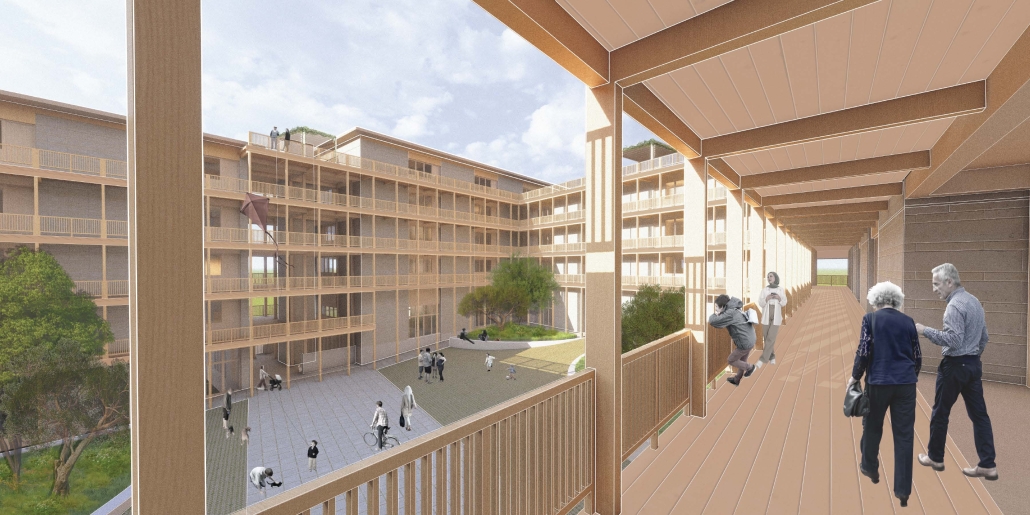
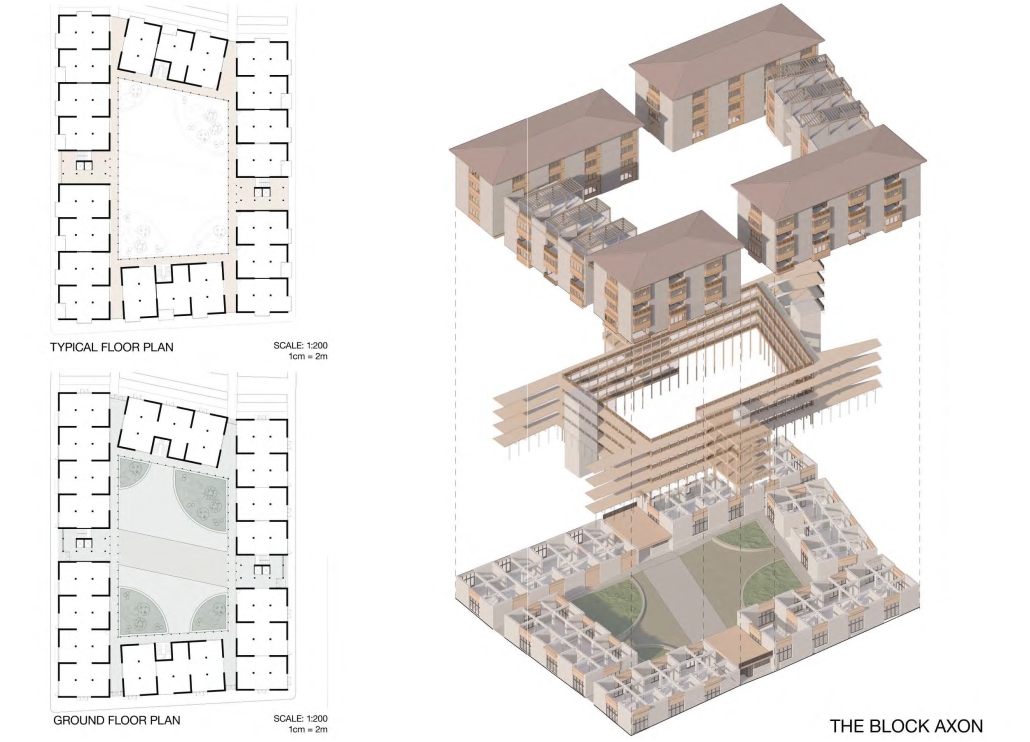
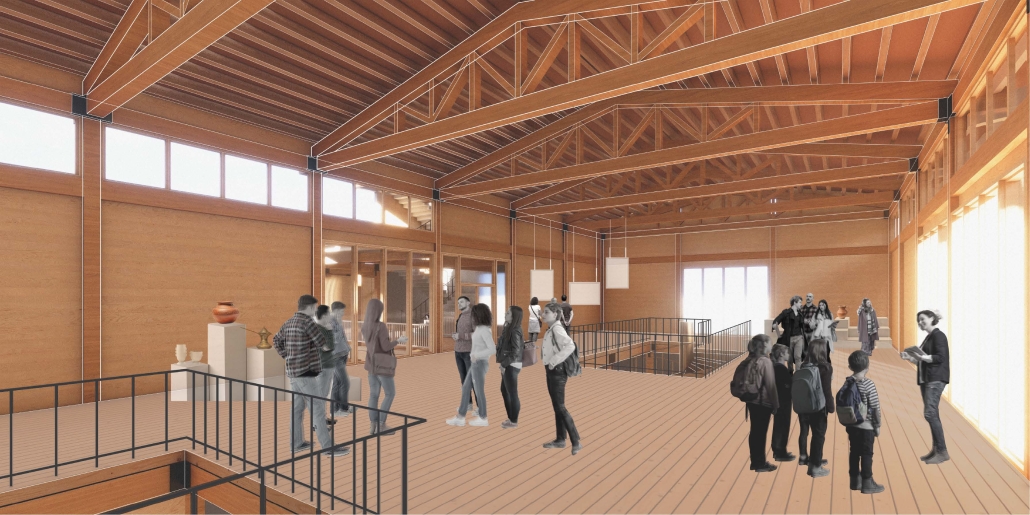















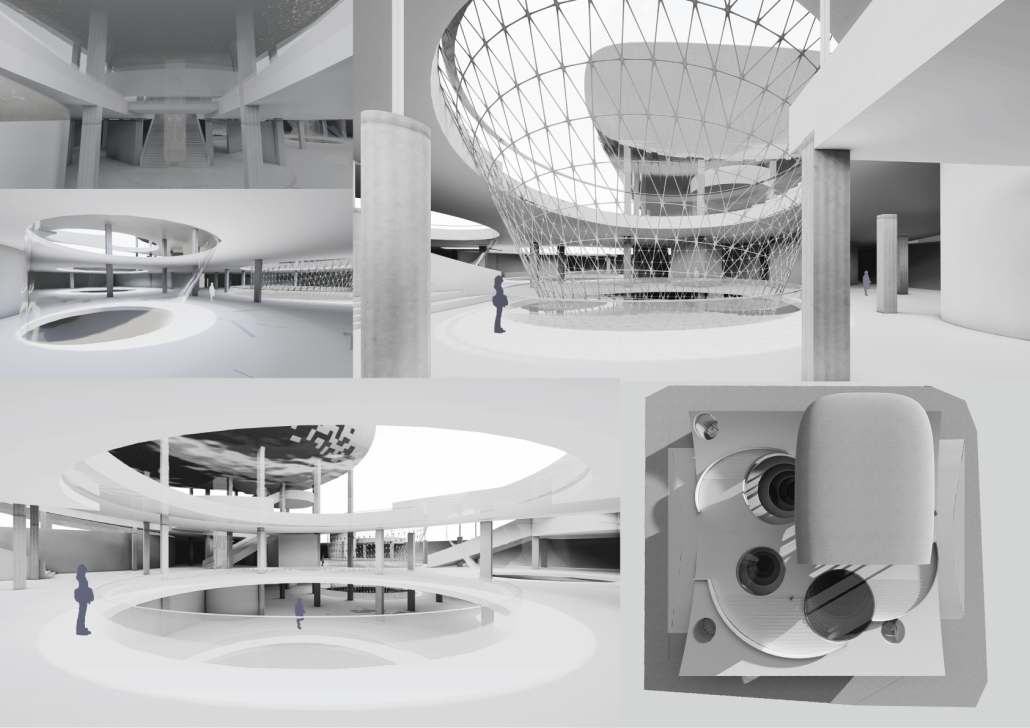
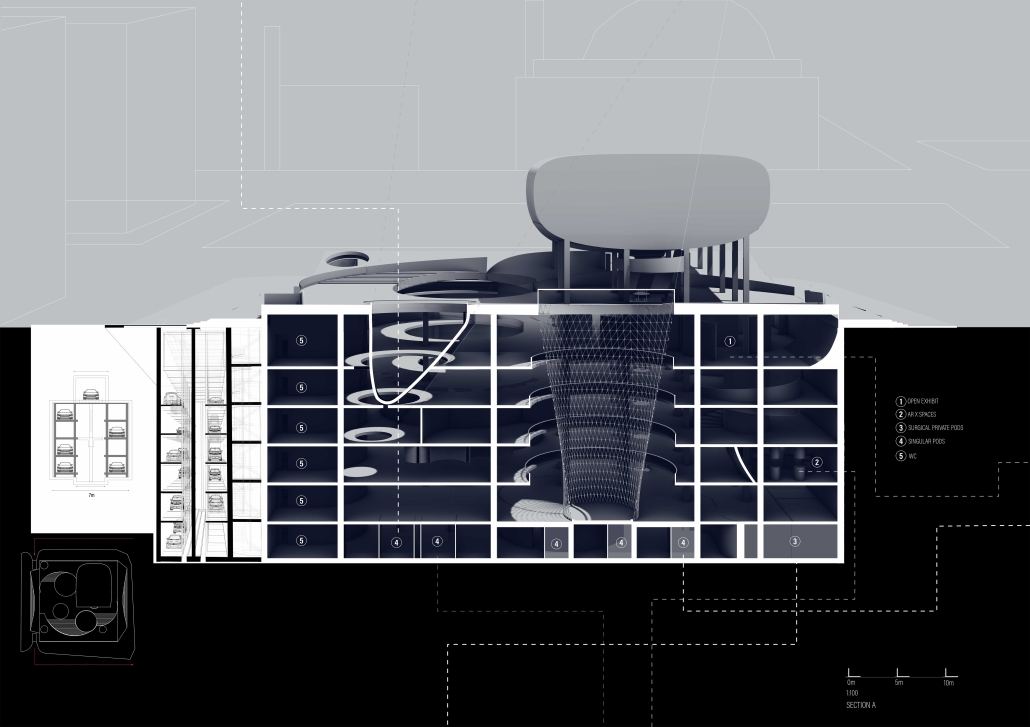









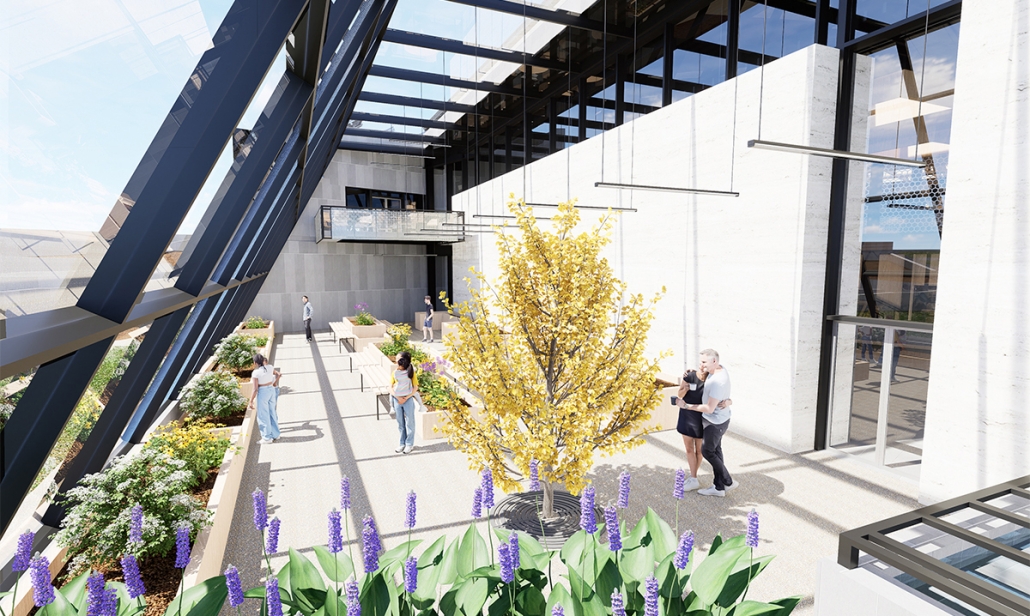







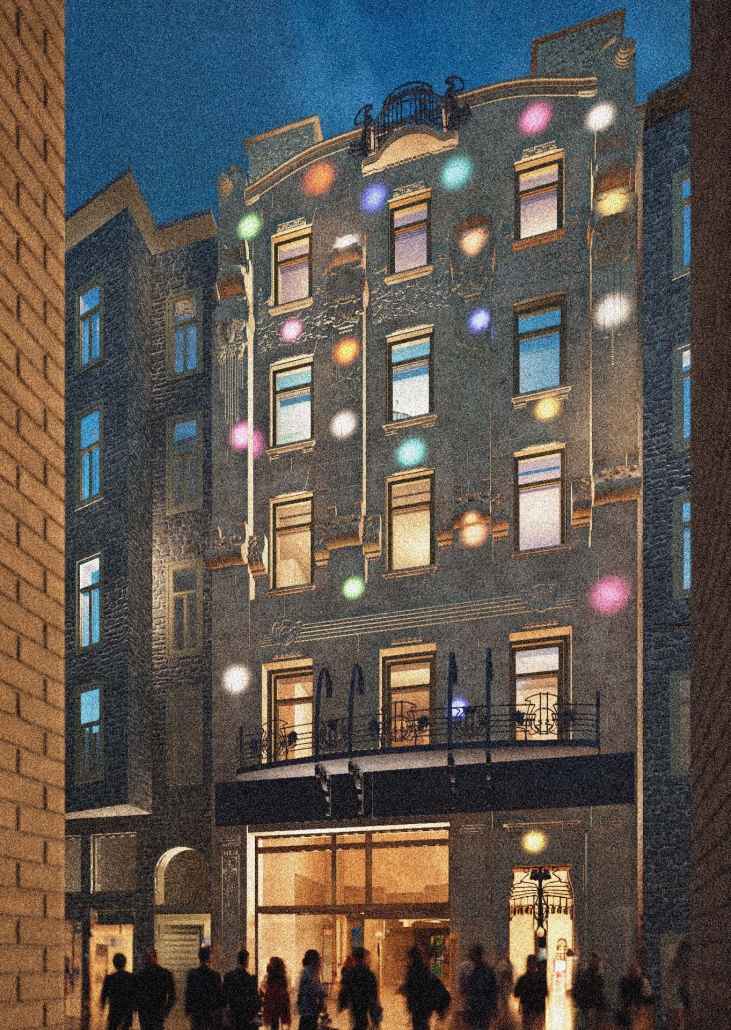


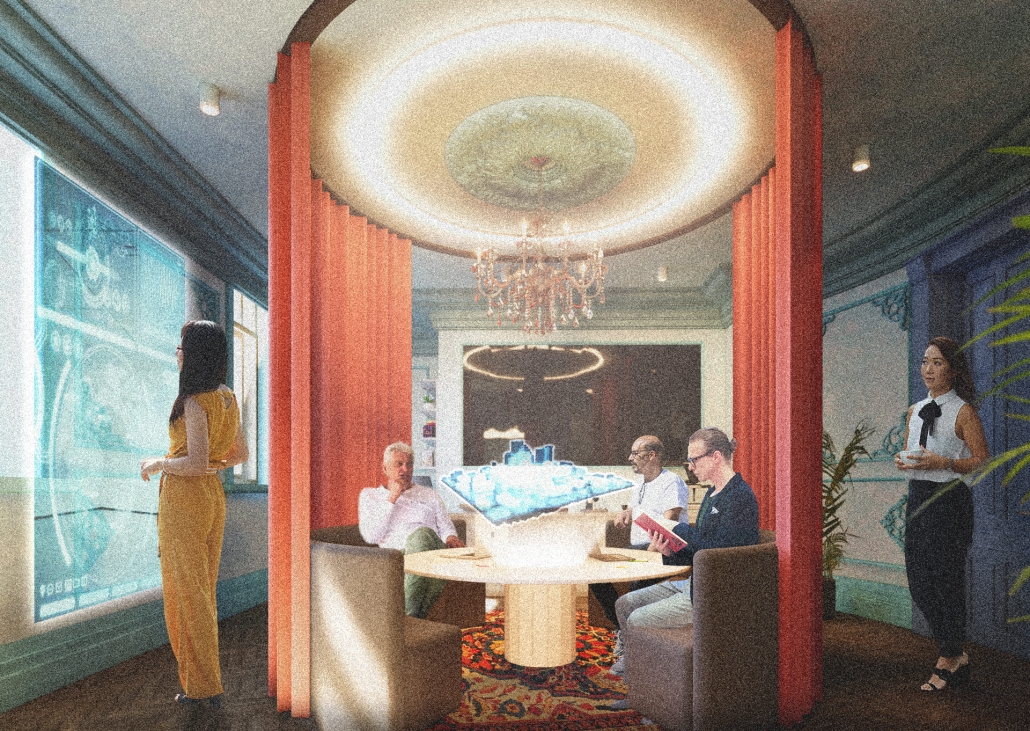
























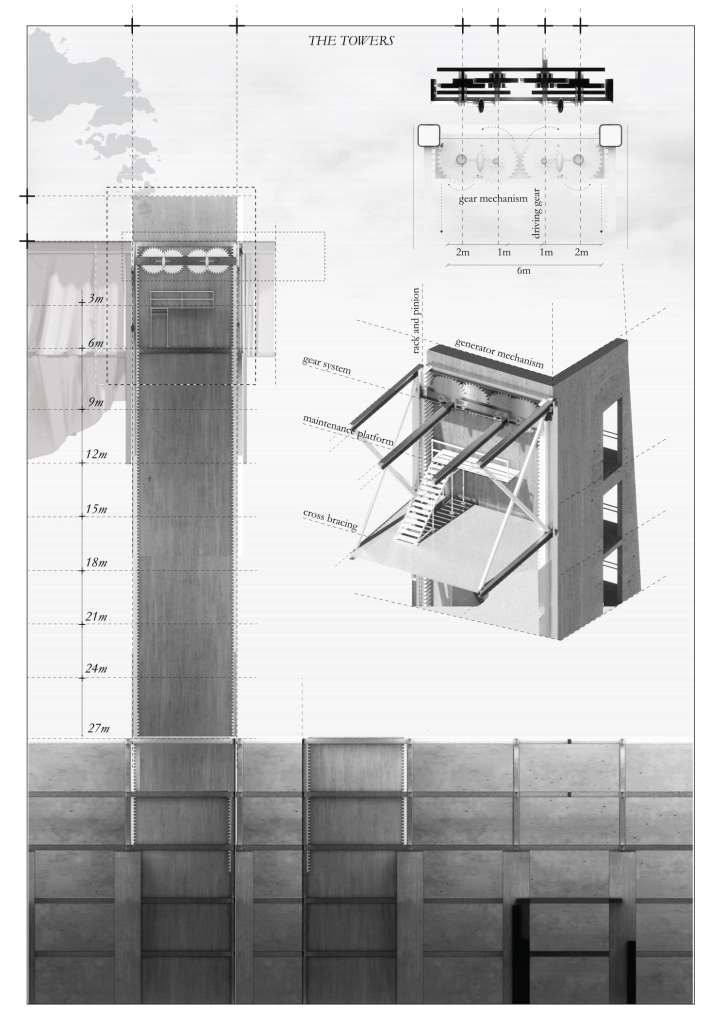




















































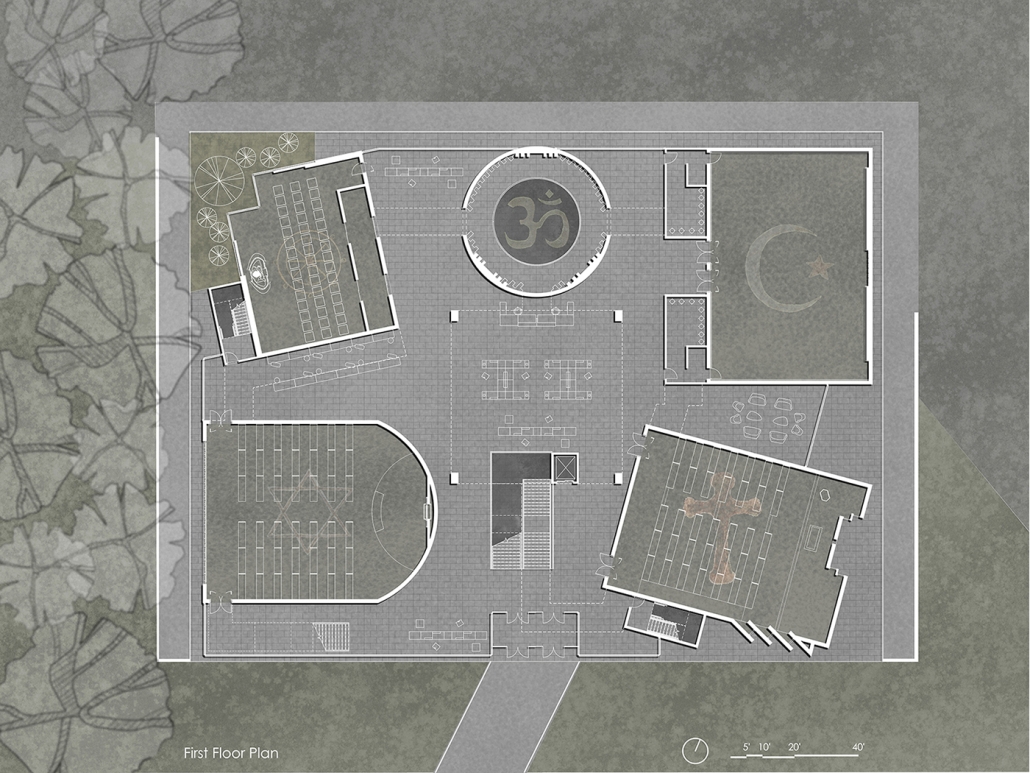
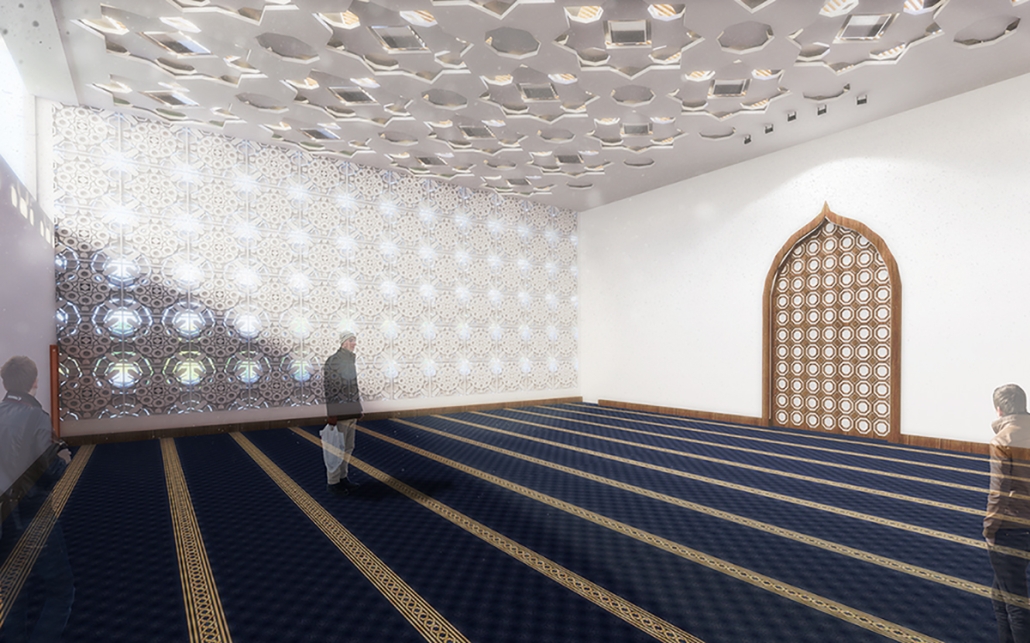

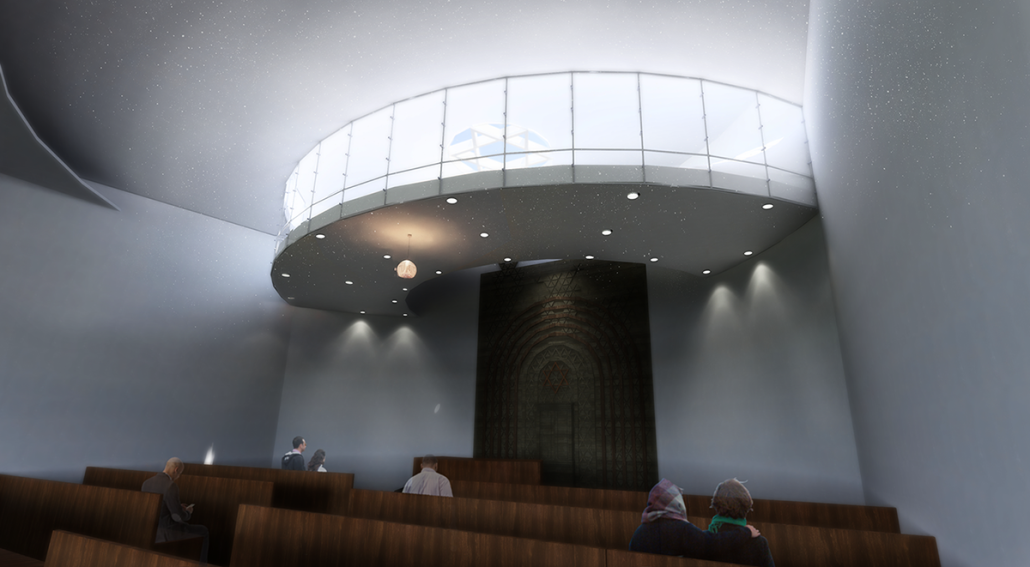
























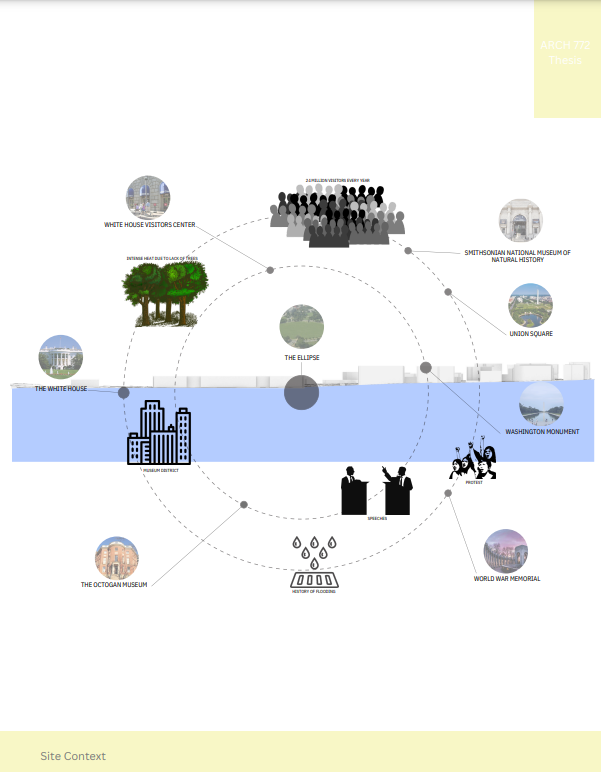








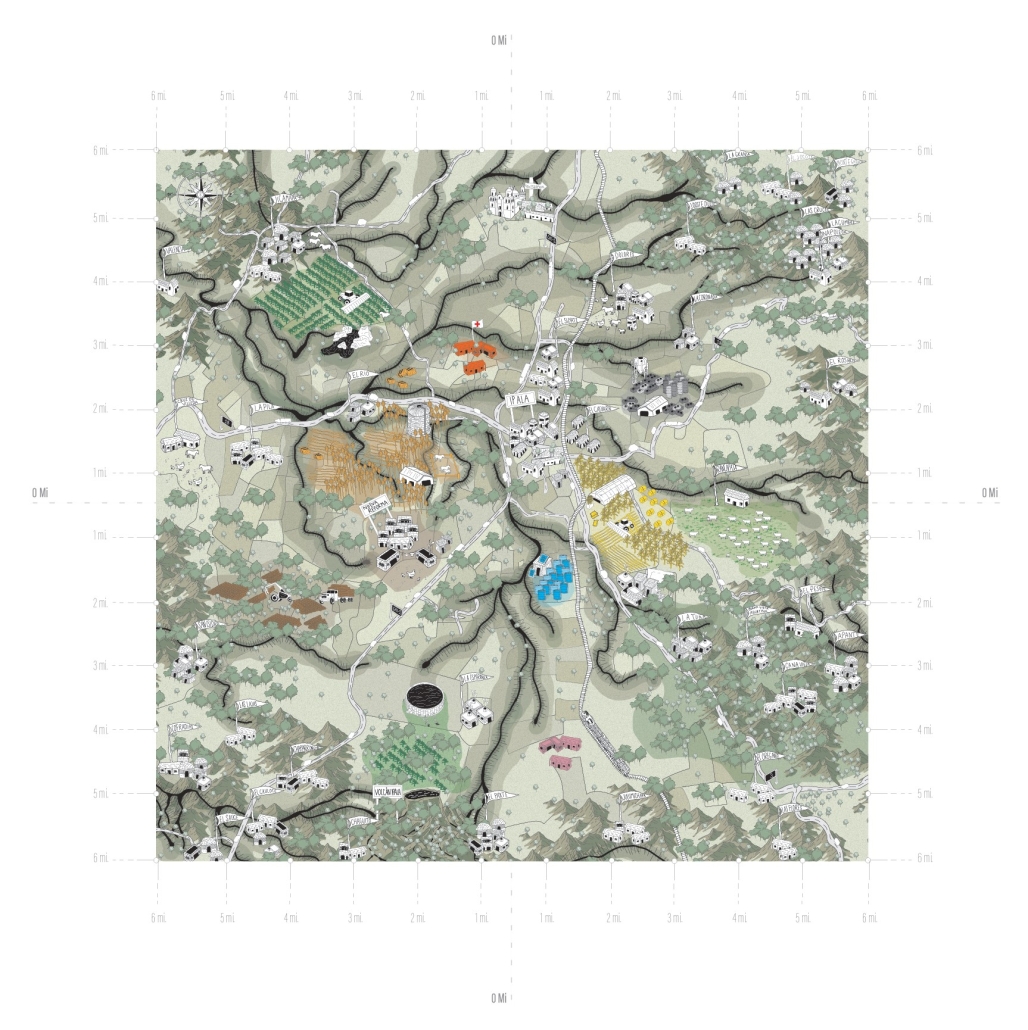


















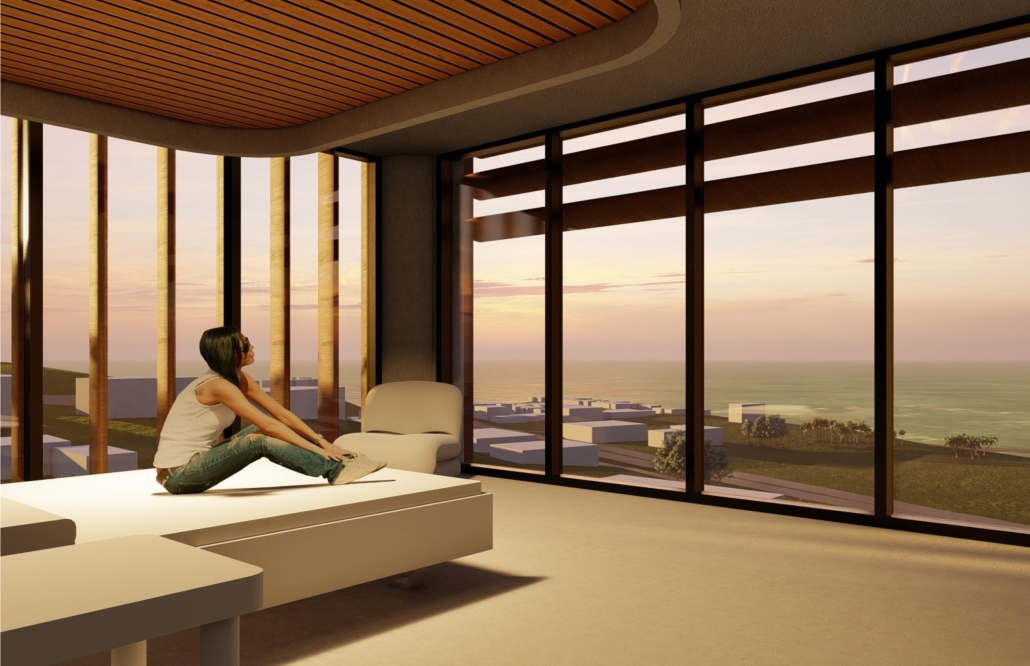























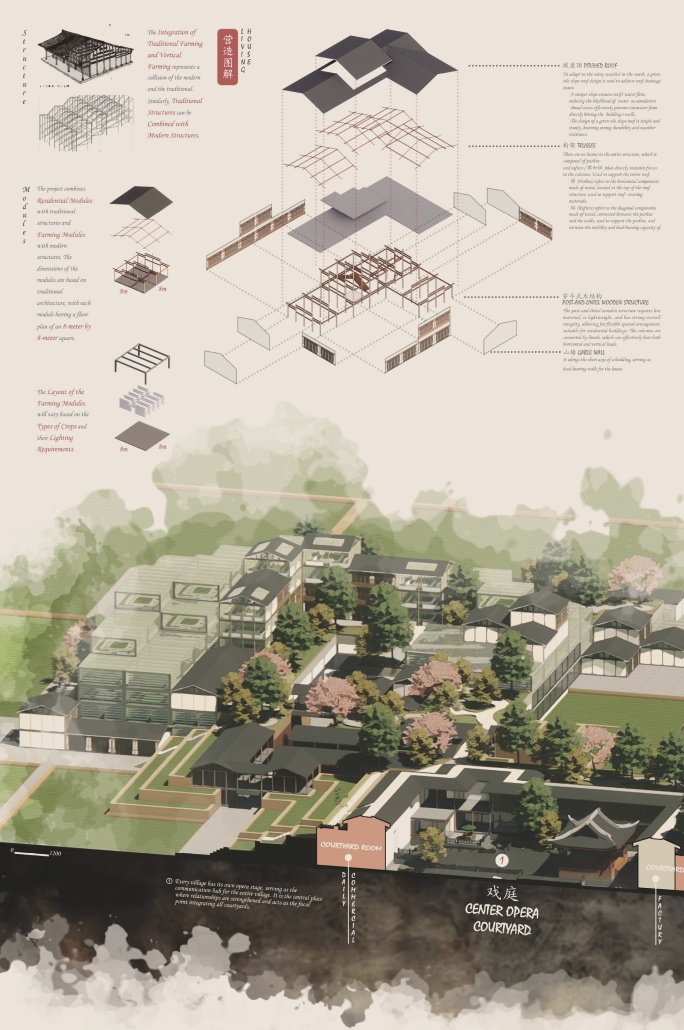







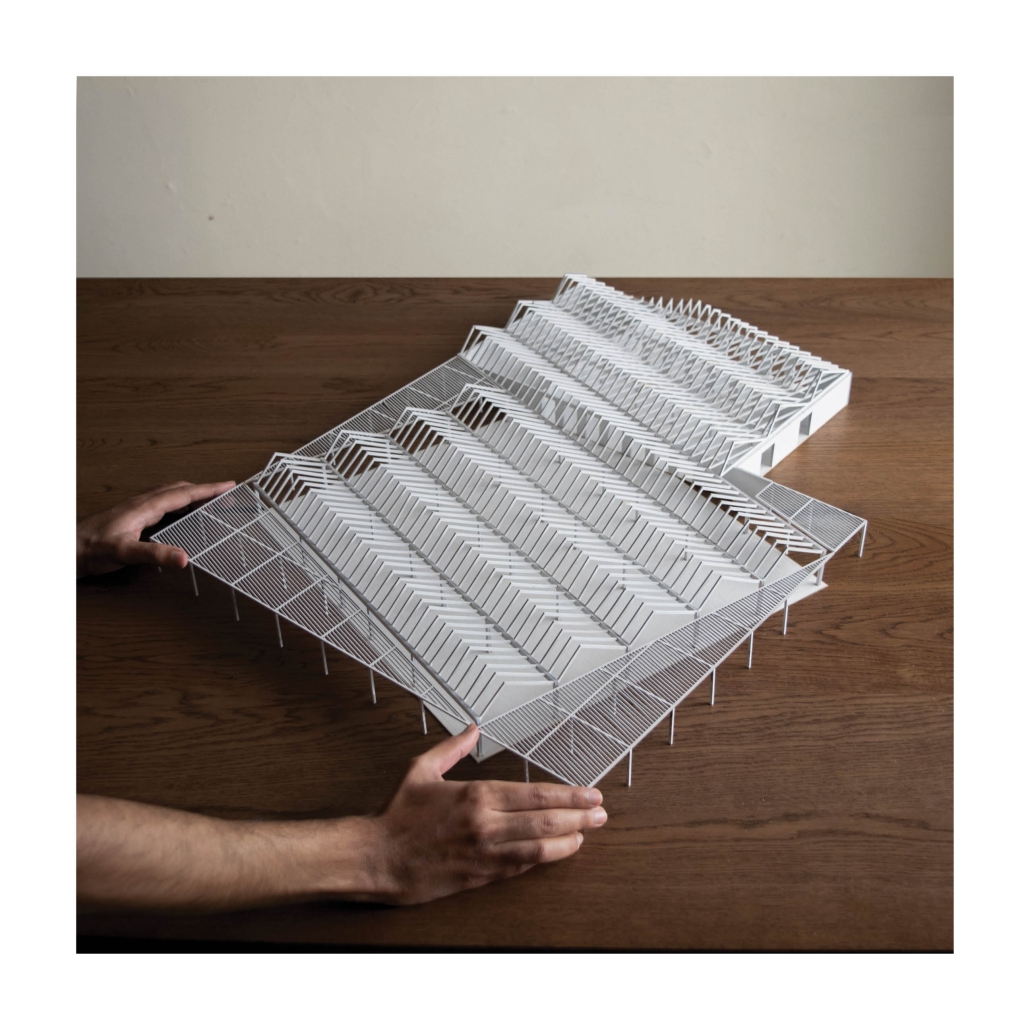


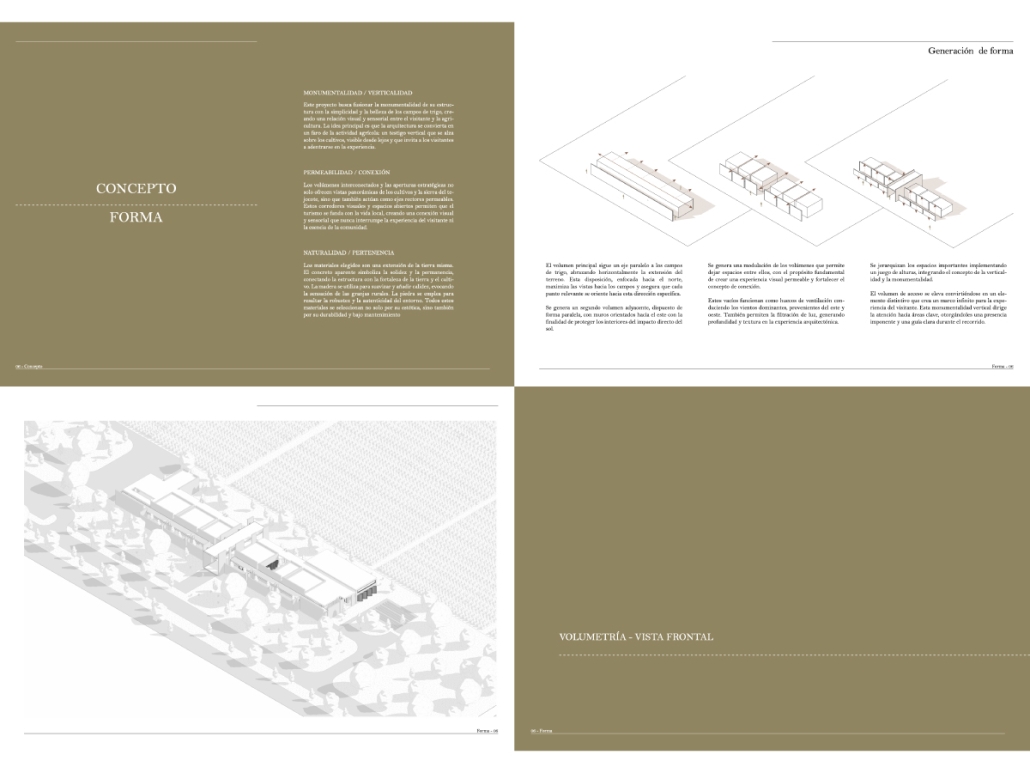

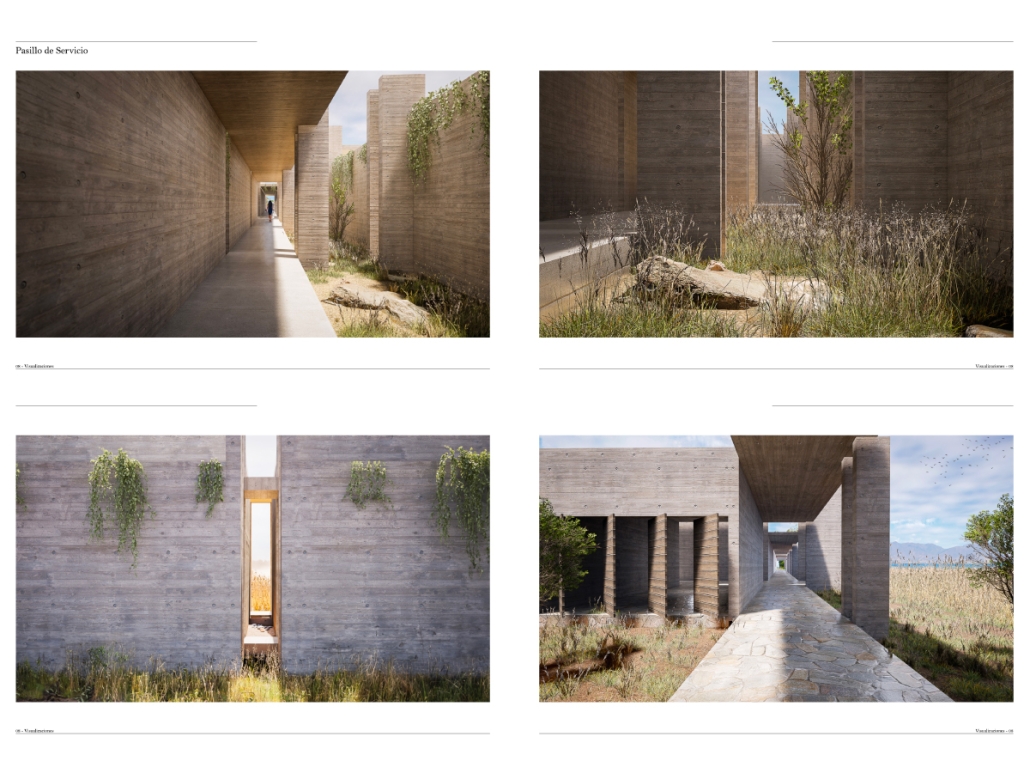





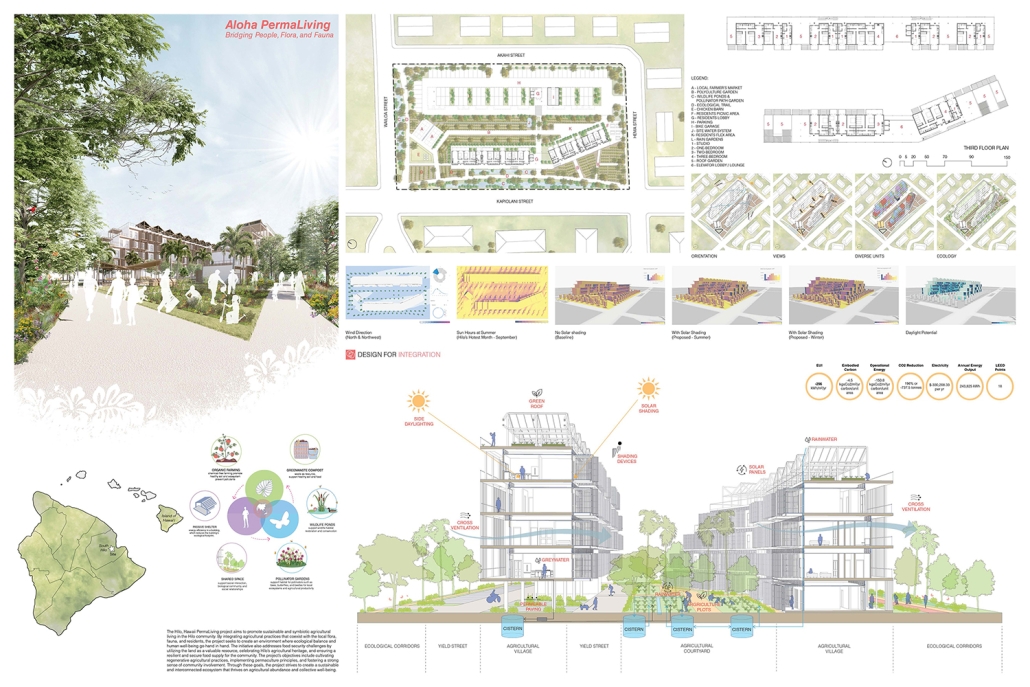




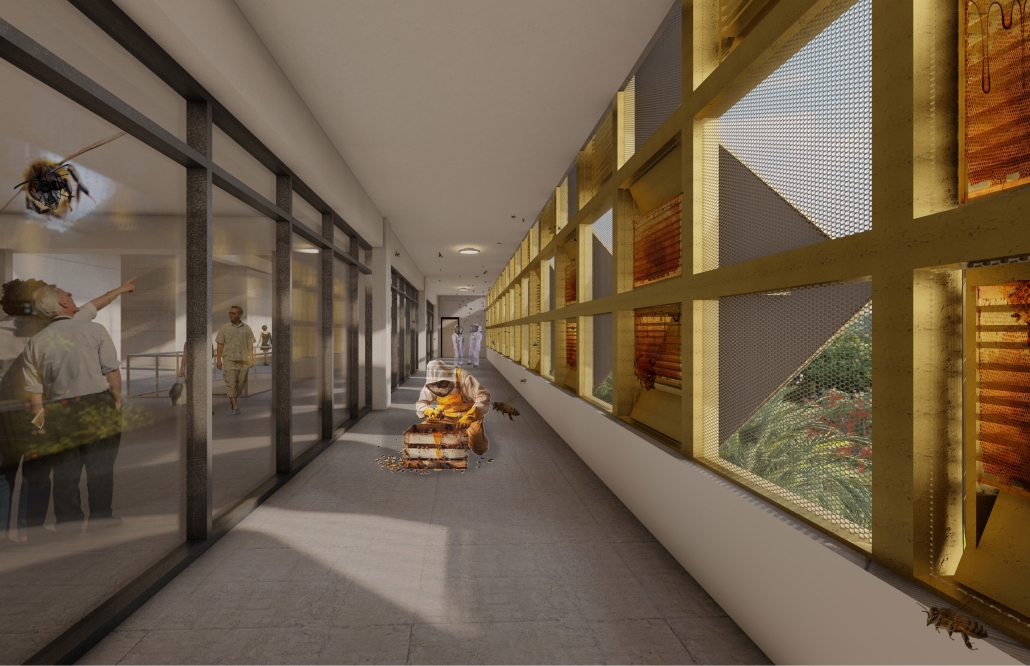
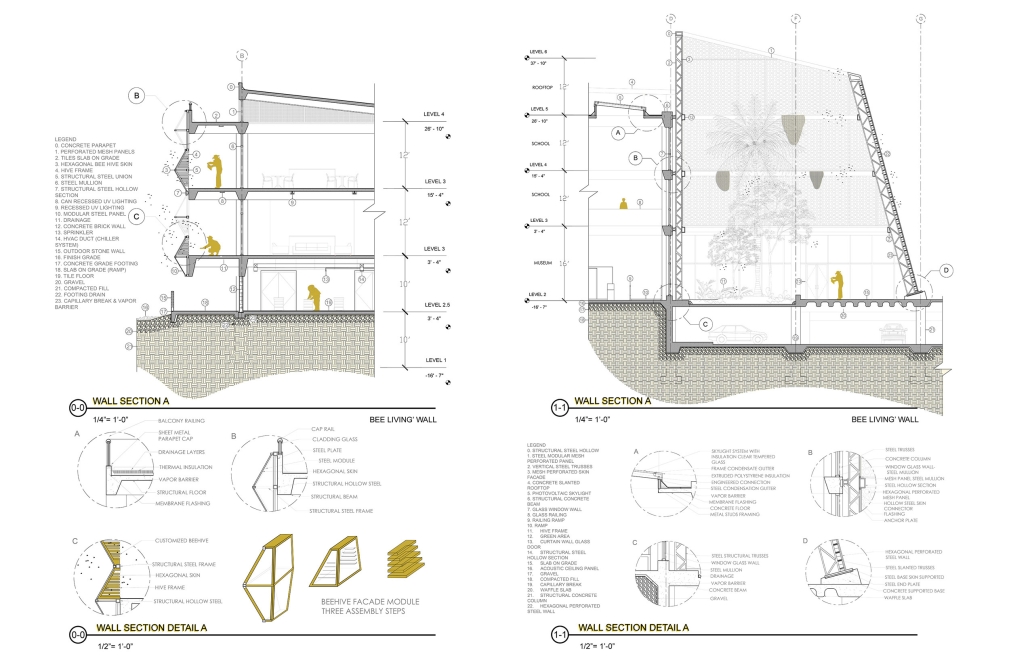




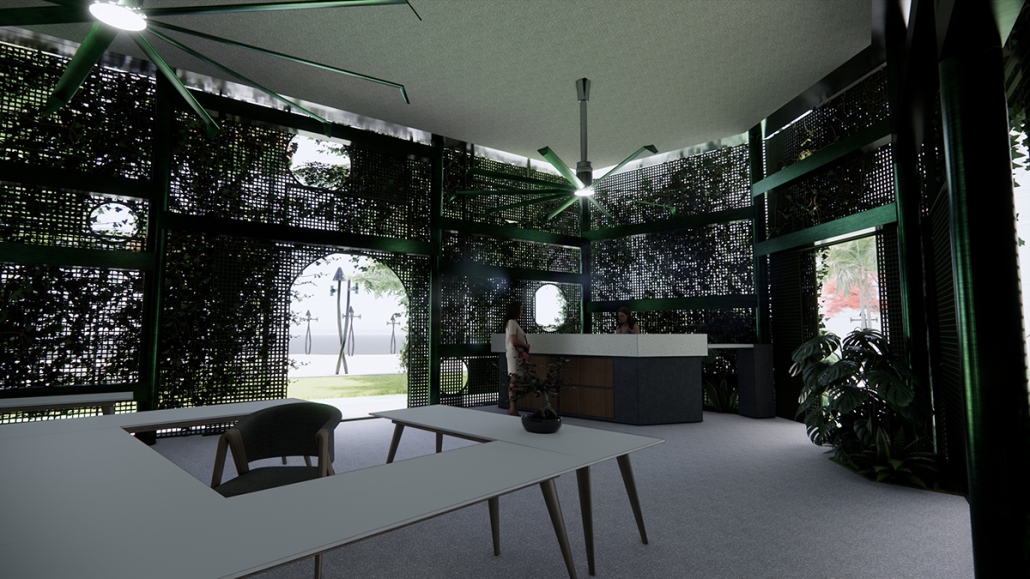













![music room [Converted]](https://studyarchitecture.com/wp-content/uploads/musicRoom-copy-2-Maggie-McMickle-1030x1004.jpg)


